Karl Shuker's Blog, page 45
July 4, 2014
THE EMELA-NTOUKA – NEW CORROBORATIVE EVIDENCE FOR THE CONGO'S CRYPTIC 'KILLER OF ELEPHANTS'?
 Reconstruction of the emela-ntouka (© David Miller under the instruction of Prof. Roy P. Mackal)
Reconstruction of the emela-ntouka (© David Miller under the instruction of Prof. Roy P. Mackal)I've been promising ShukerNature readers for almost a year now that I'd write up this fascinating discovery and post it – so now I have done, and here it is!
A little over 30 years ago, the most famous creatures of cryptozoology were Nessie, the yeti, a sundry array of sea serpents, and the North American bigfoot. In 1982, however, following his return to the USA in December 1981 at the end of the second of two expeditions to the People’s Republic of the Congo (formerly the French Congo), veteran American cryptozoologist Prof. Roy P. Mackal revealed to an astonished media and general public that the elusive swamp monster that he had been searching for in the Congo may conceivably be a living dinosaur! A new cryptozoological star had been born – an elusive long-necked mystery beast bearing an extraordinary outward resemblance to a sauropod, and known to the local Congolese pygmies as the mokele-mbembe. But this wasn't the only Congolese cryptid that Mackal's team had learnt about during their forays there. Less familiar but definitely no less interesting was a second major mystery beast claimed by the pygmies to inhabit that country's vast Likouala swamplands – a truly extraordinary (and exceedingly formidable) creature known to them as the emela-ntouka, or ‘killer of elephants’.
 Another reconstruction of the emela-ntouka (© Hodari Nundu/Deviantart.com)
Another reconstruction of the emela-ntouka (© Hodari Nundu/Deviantart.com)The size of an elephant itself, but semi-aquatic, the emela-ntouka is said to have a long heavy tail, four sturdy legs, and, most notable of all, a very long, sharp horn borne upon its snout. On first sight, this cryptid sounds like some form of rhinoceros. However, its long heavy tail differs dramatically from the short, lightweight version possessed by all known rhino species. So too does its horn, for whereas those of rhinoceroses are nothing more than masses of compressed hair, according to native testimony the emela-ntouka’s is said to resemble the ivory tusk of an elephant. As ivory is only associated with tusks and teeth, not horns, however, it is probable that if the pygmies' claim about it is correct, the emela-ntouka's horn is composed of bone.
Its behaviour is also very distinctive. Although wholly herbivorous, the emela-ntouka is claimed to be extremely belligerent, so much so that if even something as mighty as an elephant or buffalo enters a lake in which one of these creatures is residing, the latter will not hesitate to attack the intruder - stabbing and disembowelling its hapless victim with its formidable snout-horn.
 An emela-ntouka facing off a wary herd of elephants (© William Rebsamen)
An emela-ntouka facing off a wary herd of elephants (© William Rebsamen)Following his own investigations of this extraordinary beast, Mackal proposed, albeit cautiously, that it may actually be a surviving ceratopsian or horned dinosaur – i.e. belonging to a group of huge herbivorous dinosaurs that included such prehistoric stalwarts as Triceratops and Styracosaurus. Many ceratopsians possessed more than one horn, but at least one famous example, Centrosaurus(formerly called Monoclonius), bore only a single horn, at the end of its nose – and reconstructions of Centrosaurus certainly recall descriptions of the emela-ntouka. Moreover, because the horns of ceratopsians were true horns (composed of bone), not compressed hair, they may well have resembled ivory, just like the emela-ntouka’s; and all ceratopsians had long heavy tails, providing yet another match with the emela-ntouka.
 Modern restoration of Centrosaurus in life (© Nobu Tamura/Wikipedia)
Modern restoration of Centrosaurus in life (© Nobu Tamura/Wikipedia)Indeed, the only major discrepancy between the pygmies' description of this cryptid and palaeontological reconstructions of ceratopsians is that the latter dinosaurs bore a huge bony frill around their neck, protecting this otherwise-vulnerable body region from attack by carnivorous dinosaurs, whereas no such frill has been reported for the emela-ntouka. However, if the latter beast is indeed a surviving ceratopsian, it is the product of 64 million years of continued evolution, i.e. from when the most recent fossil ceratopsians died out right up to the present day - a immense period of time during which evolution could readily have engineered the reduction or complete elimination of a frill (especially as such a heavy accoutrement would no longer be needed following the extinction of the mighty carnivorous dinosaurs).
Equally interesting is that, as with the mokele-mbembe, reports of creatures resembling the emela-ntouka are not confined to the Congo’s Likouala swamplands. The Democratic Republic of Congo (formerly Zaire) also has its own counterpart, dubbed the irizima, and there are even reports from as far west as Liberia. Moreover, several notable East African lakes, including Lakes Bangweulu, Mweru, and Tanganyika, as well as the Kafue swamps, are said to be inhabited by a very comparable cryptid known as the chipekwe, which kills hippopotamuses with its horn, but does eat them. Occasionally, one of these aggressive animals has itself been killed by native hunters, but, sadly, no remains have ever been made available for scientific analysis. However, the ivory-like horn is said to be highly prized by them, so perhaps there is a chipekwe horn or two preserved in a local chief’s dwelling somewhere in East or Central Africa and awaiting discovery by a sharp-eyed Western explorer, scientist, or missionary?
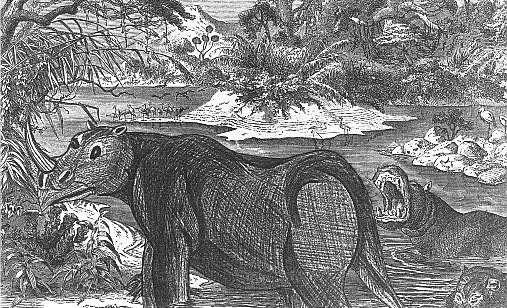 The emela-ntouka/chipekwe as portrayed in its jungle swampland domain, complete with hippos! (© Dr Karl Shuker)
The emela-ntouka/chipekwe as portrayed in its jungle swampland domain, complete with hippos! (© Dr Karl Shuker)Meanwhile, French cryptozoologist Michel Ballot has lately found what may be the next best thing. Since 2004, he has conducted a number of excursions into Cameroon, seeking evidence for the existence of unknown aquatic beasts. In 2005, during his second expedition, travelling through a region of northern Cameroon bordering the Central African Republic, he visited a village where he saw (and purchased) a large, truly remarkable wooden carving. It depicted in great detail a strange beast with four sturdy legs, a long heavy tail, and a head whose nose bore a long horn.
Although this carving doesn’t match any known animal alive today, as can be seen from the photograph of it reproduced below in this present ShukerNature blog article (and also click here for Michel's own account of it, with additional photos) it is a faithful representation of the emela-ntouka.
 Photograph of the more detailed, better-known of the two emela-ntouka carvings encountered by Michel Ballot in Cameroon(© Michel Ballot)
Photograph of the more detailed, better-known of the two emela-ntouka carvings encountered by Michel Ballot in Cameroon(© Michel Ballot)Interestingly, this carving portrays the emela-ntouka with a pair of small frilly ears, almost like miniature elephant’s ears, a feature not previously reported for this cryptid but which, if genuinely possessed by it, indicates a mammalian rather than a reptilian identity. Moreover, in his own account Michel revealed that in 2005 he had actually found not one but two such carvings, in separate locations and created by separate artists, but identical in appearance. Judging from the photo below of the second one, however, it is less detailed and less well-executed than the first, more famous carving.
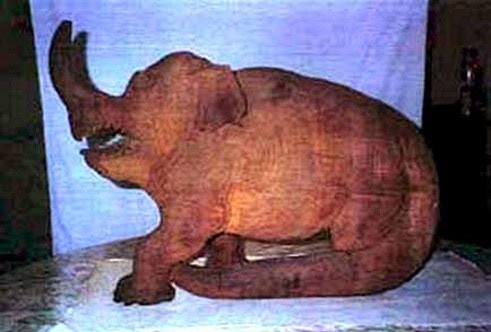 Photograph of the second, less-publicised emela-ntouka carving encountered in Cameroonby Michel Ballot (© Michel Ballot)
Photograph of the second, less-publicised emela-ntouka carving encountered in Cameroonby Michel Ballot (© Michel Ballot)Now, in a ShukerNature world-exclusive, I can reveal a third, independently-obtained but undeniably corroborative piece of iconographical evidence for the veracity of this specific morphological identikit relative to the emela-ntouka.
And here is where that remarkable piece of evidence came to light. Situated in the Central African Republic (CAR), to quote from their website (click here ) the Dzanga Sangha Protected Areas or APDS:
"…are internationally known for their beautiful rainforests, host to a remarkable diversity of wildlife, comprising western lowland gorillas, forest elephants, bongo antelopes, forest buffalos and a multitude of bird species. Furthermore, a rich local culture, comprising the Sangha Sangha fishermen as well as hunting and gathering BaAka, are present in the area. Apart from conservation and local development efforts, Dzanga Sangha operates as an eco-tourism and research centre. A variety of well developed tourism activities and a beautiful hotel complex, overlooking the Sangha River, are at your disposal.
"Sharing borders with Cameroun and Congo, the Dzanga Sangha Protected Areas are part of the Trinational Sangha (TNS) complex, currently in the process to become a UNESCO World Heritage Site. Roundtrips to the other National Parks (Lobéké in Cameroun and Nouabalé Ndoki in Congo) can be organized with ease."
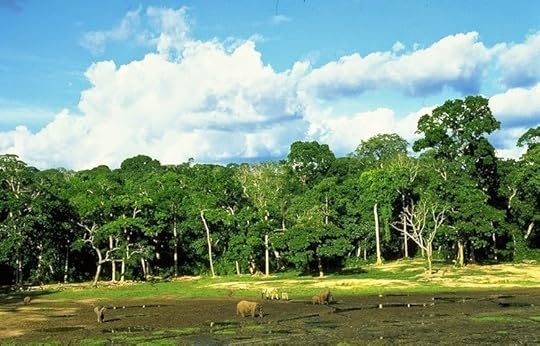 Dzanga Sangha (public domain)
Dzanga Sangha (public domain) On 8 August 2012, I receieved a fascinating email and attached set of four photographs from Anette Stichnoth of Hannover, Germany. The photographs, taken by a friend of hers from the above-mentioned APDS and named Cem Kok, were of four drawings on display at the first, now-dismantled Dzanga Sangha Exhibition (Cem was currently working on the second one), held in the APDS - with whom Anette was working in the capacity of utilising its exhibition's artworks as designs on souvenirs, such as t-shirts and mugs, that could be sold to APDS visitors in order to raise money for the area's continuing conservation. In relation to this, she asked me if I had any idea what the entities were that the drawings depicted, because she wanted to produce an information card for each one but no-one whom she had previously contacted had been able to identify them.
The artist responsible for these four drawings was a Frenchman named Jean Claude Thibault, who had produced them during the early 1990s or late 1980s. He had lived in the Central African Republic (a former French colony) for a number of years, but could not be contacted personally concerning his drawings because he had died in Bangui, the CAR's capital, a couple of years ago.
After examining Thibault's drawings, it was clear to me that they were nothing if not interesting from a cryptozoological standpoint. Three of them depicted humanoid or semi-humanoid beings, and will be documented in a future ShukerNature blog article - but the fourth one was very different, and is reproduced below.
 Thibault's fourth drawing from the first Dzanga Sangha Exhibition (© Jean Claude Thibault)
Thibault's fourth drawing from the first Dzanga Sangha Exhibition (© Jean Claude Thibault)As can be seen, it portrays what appears to be a herd of fleeing elephants in the background plus a mokele-mbembe or similar cryptid that has been decapitated by a horned beast that bears an uncanny resemblance to Michel Ballot's Cameroon-procured emela-ntouka carvings!
In order to compare those works of art directly, I have horizontally flipped one of Michel's photographs of the more detailed of the two Cameroon emela-ntouka carvings, thereby enabling its orientation to match that of the creature in Thibault's drawing. So here now are the two images placed alongside one another:
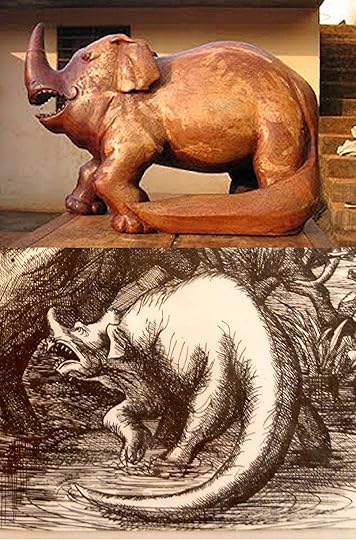 Michel Ballot's Cameroon-procured emela-ntouka carving (top); and Thibault's Dzangha Sangha Exhibition drawing, cropped to concentrate upon the horned beast depicted in it (bottom) (© Michel Ballot/(© Jean Claude Thibault)
Michel Ballot's Cameroon-procured emela-ntouka carving (top); and Thibault's Dzangha Sangha Exhibition drawing, cropped to concentrate upon the horned beast depicted in it (bottom) (© Michel Ballot/(© Jean Claude Thibault)And as can be readily discerned, there is no doubt whatsoever that these two artworks are indeed depicting the same species of animal – whatever that may be! Every major morphological feature - from those strange little frilly ears, and sharp vertical snout-horn, to the very long, broad, sweeping tail with its distinctive dorsal ridge or keel, and the relatively short, sturdy, bent legs with well-differentiated digits - is portrayed in an identical manner by the carving and the drawing. Even the seemingly stylised, non-differentiated pointed teeth are the same in both pieces.
Fascinated by this extraordinary correspondence between works of art created in two entirely different countries by artists very unlikely to have ever seen each other's work, I swiftly emailed Anette for additional information. Unfortunately, however, she didn't have anything further of substance to offer me at that time, but promised to contact me again once she had obtained more details – and almost exactly a year later, she did so.
On 18 August 2013, Anette emailed me a series of descriptions for the four drawings that she had lately been given by a CAR local with knowledge of his country's legendary creatures and entities, and the one depicting the decapitated mokele-mbembe with the emela-ntouka was indeed labelled as 'Mokele-Mbembe'. However, Anette's informant had applied this name not to the long-necked beast but to the horned one, the emela-ntouka – but native terminological confusion between these two cryptids is not unknown, having been noted by Mackal and other Westerners investigating them.
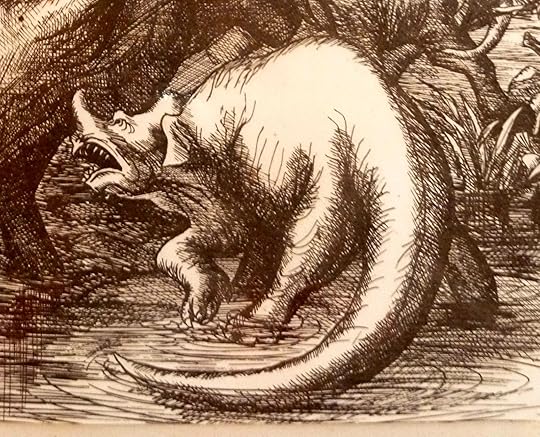 Cropped version of Thibault's emela-ntouka drawing (© Jean Claude Thibault)
Cropped version of Thibault's emela-ntouka drawing (© Jean Claude Thibault)Due to how astonishingly similar Thibault's CAR emela-ntouka drawing was to Michel Ballot's Cameroon emela-ntouka carvings, I had initially wondered whether the former had been directly copied from the latter. Perhaps Thibault had seen online images of the Cameroon carvings? However, when I learnt that Thibault had produced the drawing a decade or more before Michel had even encountered the carvings, let alone photographed them and brought them to public attention by uploading the photos onto the internet, it is surely evident that they are of independent origin, neither one influenced by the other. After all, it is highly unlikely that the Cameroon villagers responsible for the carvings had ever seen Thibault's drawing in the Central African Republic, a drawing that was only exhibited publicly several years after Michel had encountered the carvings.
Consequently, as the carvings and the drawing correspond with one another so closely, we must conclude that the image of the emela-ntouka provided by them is an accurate one – that it really does possess small frilly ears, a vertical snout-horn, bent legs, and a very broad, lengthy, powerful tail. The ears alone are enough to demonstrate that it is clearly mammalian in nature, thereby eliminating a surviving ceratopsian dinosaur from serious consideration in the future. Yet it does not compare with any known species of mammal. Indeed, it is not even possible to allocate this mysterious creature with ease to any existing taxonomic order of mammals. Having said that, however, the image of it yielded by the carvings and the drawing does remind me a little of Arsinotherium zitteli.
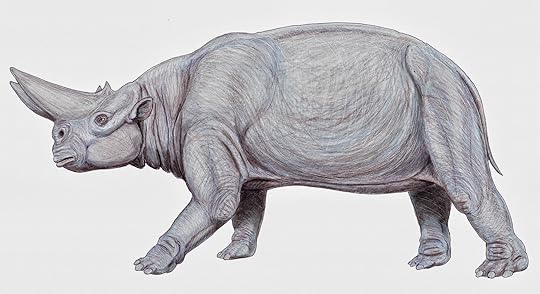 Restoration of Arsinotherium zitteli (© Dmitry Bogdanov/Wikipedia)
Restoration of Arsinotherium zitteli (© Dmitry Bogdanov/Wikipedia)Dating from the late Eocene, this was a massive elephantine horn-bearing species of fossil African ungulate belonging to the extinct order Embrithopoda. It was believed to have been aquatic in lifestyle, spending much of its time wading and swimming in rainforest swamps rather than walking on land, as it was unable to straighten its legs (thus recalling the emphatically bent legs of the emela-ntouka depicted in the drawing and carvings). Moreover, it is particularly famous for its pair of truly enormous, laterally-sited snout horns, composed of bone but hollow and covered in keratinised skin. According to their known fossil record, embrithopods officially died out almost 30 million years ago (Arsinotherium was their last known genus), but could the emela-ntouka possibly be a single-horned, scientifically-undiscovered, modern-day representative? Going full circle, a more conservative alternative would be a species of semi-aquatic water rhinoceros, as first suggested by certain cryptozoologists many years ago. Yet in spite of its single horn, the heavy-tailed creature portrayed by the carvings and drawing bears scant resemblance to any of the diverse array of rhino forms on record from either the present day or prehistoric times.
Currently, therefore, the emela-ntouka remains an enigma, but at least it is one that now appears to have a well-defined albeit extremely perplexing morphology.
 Swedish artist Richard Svensson's delightful take on the emela-ntouka (© Richard Svensson)
Swedish artist Richard Svensson's delightful take on the emela-ntouka (© Richard Svensson)If you wish to learn more about or offer assistance to the Dzanga Sangha Protected Areas (APDS), please visit their website here .
For an extensive account of the emela-ntouka, chipekwe, and other African counterparts, check out their coverage in my book In Search of Prehistoric Survivors (1995).

Published on July 04, 2014 17:31
July 3, 2014
THE 'OTHER' ENCOUNTER BETWEEN A BRITISH SAINT AND A LAKE MONSTER
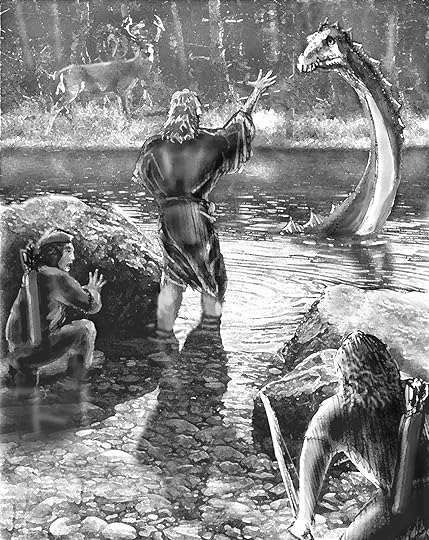 St Mochua and the lake monster of Connaught, Ireland (© William Rebsamen)
St Mochua and the lake monster of Connaught, Ireland (© William Rebsamen)Every self-respecting cryptozoologist knows – or should know – about the famous encounter claimed for St Columba and the Loch Ness monster during the 6th Century AD (its specific date varies from one authority to another). Having said that, in reality the encounter apparently took place not in the loch itself but in the River Ness – so the creature in question may not have had any bearing upon the cryptids allegedly frequenting the loch, but may simply have been a vagrant sea creature of known form, such as a bearded seal or possibly even a walrus.
Anyway, regardless of its specifics, this encounter is, as I say, a very famous one in the annals of cryptozoology.
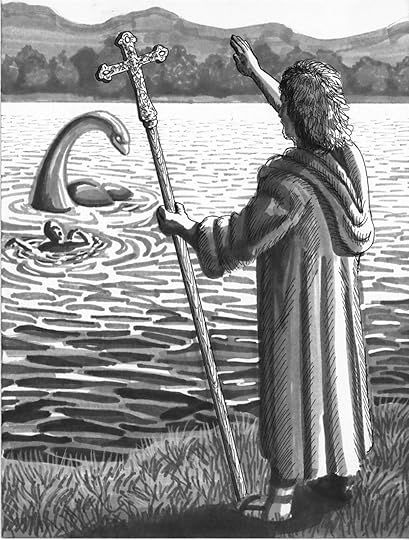 St Columba confronting the monster in the River Ness (© William Rebsamen)
St Columba confronting the monster in the River Ness (© William Rebsamen)Far less famous, however, yet no less interesting, is the 'other' encounter between a British saint and a lake monster – which is the subject of this present ShukerNature blog post.
Born Crónán mac Bécáin sometime during the late 6thCentury or early 7th Century AD (his age upon death is unrecorded but he is known to have died on 30 March 637 AD), St Mochua as he became was a notable early Irish saint. After completing his education at Bangor, he was reputedly led through many regions of Ireland by a miraculous fountain that could move of its own accord, and during that time he performed a considerable number of miracles himself. One of these involved a lake monster.
At one point during his fountain-guided travels, Mochua crossed the River Shannon and entered the territory of Omania (aka Hy-Many) in the province of Connaught, where he visited Kellach, who was the son of Ragallus, king of Connaught. During Mochua's stay, Ragallus went out hunting a stag, which in order to escape pursuit, leapt from a steep precipice on the shore of a lake and swam to a large rock, jutting forth above the lake's waters like a small island, where the creature sought sanctuary. Different reports cite different lakes (or loughs) as being the one in question here – including County Galway's Lough Ree, Lough Cime or Cimbe (aka Hackett), and Lake Raminium.
 Lough Ree (public domain)
Lough Ree (public domain)According to traditional legend, Mochua had stated that God would safeguard anyone who was bold enough to dive into the lake and swim after the stag, so with Ragallus's permission one brave man did precisely that, reaching the rock-island and killing the stag. When he attempted to swim back to the lake's shore with his slain quarry's carcase, however, a water monster that lived in this body of water and was held in great dread by the populace on account of its murderous nature suddenly rose up from the depths and promptly devoured the hapless swimmer.
When this happened, Ragallus angrily chastised Mochua, as his prediction had seemingly failed to come true, but in response Mochua confronted the monster and prayed – whereupon the monster abruptly vomited forth the swimmer, who was alive and totally unharmed. Moreover, never again did this great water beast attack any other swimmer. Ragallus and his subjects duly gave thanks to God for this miracle, and Mochua was afterwards greatly revered here.
Whether any such monster truly existed or whether this is just a hagiographical legend is unclear (who knows, it may even be derived directly from the earlier one featuring St Columba). And even if it did exist, there does not appear to be any description of the creature on record that might allow a serious attempt to be made at identifying its species.
 Reconstruction of the Lough Nahooin horse-eel – one of several horse-eels reported in modern times from the lakes of County Galway in Connaught - based upon eyewitness accounts (© Orbis Books)
Reconstruction of the Lough Nahooin horse-eel – one of several horse-eels reported in modern times from the lakes of County Galway in Connaught - based upon eyewitness accounts (© Orbis Books)Nevertheless, bearing in mind that the loughs of Connaught, including Ree, have featured prominently in modern-day reports of Irish freshwater monsters, notably those of the sinuous horse-eel variety, it is an intriguing story, and perhaps even one of bona fide cryptozoological relevance and precedence.
Check out my book In Search of Prehistoric Survivors (1995) for additional details concerning Irish horse-eels.
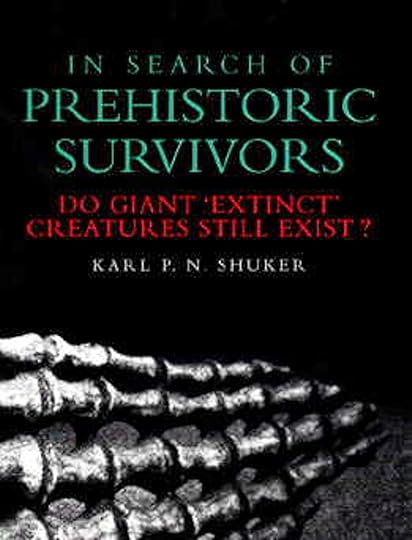
Published on July 03, 2014 17:23
July 2, 2014
THE CURIOUS CASE OF ROTHSCHILD'S LOST TUSK AND THE NON-EXISTENT ELEPHANT PIG - AN ENDURING CRYPTOZOOLOGICAL CONUNDRUM FROM AFRICA
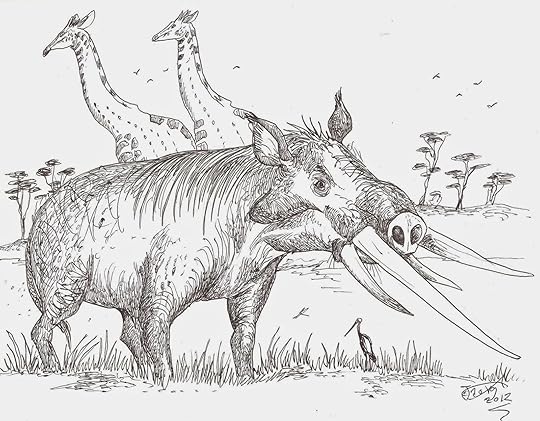 Afrochoerus
purposefully portrayed here as originally conceived when first discovered, i.e. erroneously sporting the tusks of a prehistoric elephant (© Hodari Nundu/deviantart.com)
Afrochoerus
purposefully portrayed here as originally conceived when first discovered, i.e. erroneously sporting the tusks of a prehistoric elephant (© Hodari Nundu/deviantart.com)I first came upon the following crypto-case many years ago when browsing through Dr Bernard Heuvelmans's book Les Derniers Dragons d'Afrique (Plon: Paris, 1978), and it has fascinated me ever since. Recently, I obtained some additional, previously-undisclosed information concerning it, and which turned out to be something of a conundrum in itself. Consequently, it is high time that I finally presented the remarkable story behind one of the most intriguing and potentially significant examples on record of an apparently lost specimen of possible cryptozoological relevance. So here it is – the story, that is, not the specimen itself, sadly!
It all began in an Ethiopian ivory market, one of many in this country's capital, Addis Ababa, back in the opening years of the 20thCentury. In 1904, Baron Maurice de Rothschild and French zoologist Henri Neuville were visiting this particular ivory market during an East African expedition when they noticed a very odd-looking tusk on a stall owned by some ivory merchants from India. Although in excellent condition, supposedly of modern age (i.e. not fossilised, though possibly several centuries old), and superficially similar to an elephant tusk but with a very dark patina, in terms of length it only measured 0.56 m (22 in) in a straight line and only 0.74 m (29 in) following its curve, so it was smaller than most elephant tusks of comparable proportions that they had previously sold. In addition, it bore a series of longitudinal, regularly-spaced, narrow grooves or corrugations on what appeared to be its upper side and a single long but very broad groove on its apparent underside, instead of being smooth-surfaced like regular elephant tusks. Consequently, it had not attracted interest from potential buyers.
 Three different views of the mystery tusk purchased in Addis Ababa by Rothschild and Neuville, as depicted in their 1907 paper documenting it
Three different views of the mystery tusk purchased in Addis Ababa by Rothschild and Neuville, as depicted in their 1907 paper documenting itThe ivory merchants were unable to provide any information regarding this odd tusk's original geographical provenance or from what type of animal it had been obtained. Indeed, they considered it not to be a tusk at all, but rather some form of horn. Nevertheless, intrigued by its strangeness, and no doubt encouraged by its lower-than-normal price, Rothschild and Neuville duly purchased it. Moreover, while still in East Africa, Neuville was informed by some Somali hunters and camel herders that tusks like this one came from an aquatic, hippopotamus-sized creature of great strength, whose tusks curved downwards to the ground, and which inhabited certain very large East African lakes. According to them, one of these lakes is what is now known as Lake Arbeya (formerly called Lake Marguerite) where they claimed to have seen a living specimen, and another such lake is situated on the border of Kenya and Uganda.
Following their return to Europe, Rothschild and Neuville's unusual zoological purchase was exhibited at three separate scientific meetings. Namely, the Société Philomathique of Paris on 14 January 1905; the Zoological Society of London on 14 November 1905 (where it was presented by Lord Walter Rothschild, distantly related to Maurice de Rothschild, who was a lifelong zoological researcher and prodigious collector of wildlife specimens that he housed at his own personal natural history museum at Tring in Hertfordshire); and the Academy of Sciences, Paris, on 11 December 1905. (Oddly, a short notice in the Zoological Society's Proceedingsdocumenting the tusk's exhibition there claimed that two such tusks, not one, had been obtained by Rothschild and Neuville and had been exhibited at the Society.)
Rothschild and Neuville then prepared an extensive scientific paper documenting their anomalous tusk, which was published on 15 October 1907 inthe French journal Archives de Zoologie Expérimentale et Générale (4thSeries), was over 50 pages long, and was aptly entitled 'Sur une Dent d'Origine Énigmatique'. In it, they compared the tusk closely with a range of others, including those of elephants, hippos, walruses, and wild pigs, as well as a large selection of freak, malformed elephant tusks housed at London's Natural History Museum and elsewhere. However, Rothschild and Neuville claimed that not only externally but also in terms of its internal grain structure as seen when viewed in cross-section, it differed markedly from all of them, and even from known fossil species of tusked mammal – to such an extent, in fact, that they considered it plausible that this unique specimen did indeed derive from some still-undiscovered animal species, exactly as claimed by the Somalis.
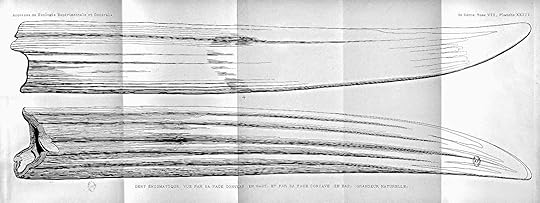 Line illustration of the Rothschild-Neuville mystery tusk, from their 1907 paper documenting it
Line illustration of the Rothschild-Neuville mystery tusk, from their 1907 paper documenting itAlthough referred to for the sake of convenience as a tusk both here in the present ShukerNature blog article and also in the Rothschild-Neuville paper, this enigmatic object was technically a tusk section, not a complete tusk, having been sectioned some way between its tip and its base, with the latter not being present. From their examination of it, Rothschild and Neuville considered that had it been present in its entirety, it would have been almost semi-circular in shape, and that the section preserved was probably derived from a right-hand tusk. Intriguingly, the tip showed no sign of having been sharpened, whereas elephants tend to sharpen their tusks' tips on hard objects that they encounter. From the trace of the pulp cavity remaining, the authors considered it likely that their perplexing tusk had exhibited continuous growth in life, like elephant tusks, rather than like normal teeth that do not grow continuously through life.
The Rothschild-Neuville mystery tusk was totally devoid of enamel (moreover, it occurs only at the onset of tusk development in elephants, whereas a thick layer is present in hippo tusks; enamel occurs at the tip in walrus tusks, though this tends to be worn off as the animal matures). However, there was a layer of cement, which, although not particularly thick, was very extensive (a cement layer replaces the enamel layer in elephant tusk development). As for its anomalous grooves, superficially similar structures are also borne upon the surface of hippo tusks, but their arrangement is very different from that of the Rothschild-Neuville mystery tusk's grooves. This is also true of the grooves that sometimes occur on wild pig tusks, and those present on various teratological tusks from elephants that were examined by the authors. Several distinctive traits can be found in diseased examples of elephant tusks, but none of those traits was exhibited by their mystery tusk, which appeared to be perfectly healthy, thus eliminating another possible explanation of it. For further morphological and histological details, please consult the meticulous description in their original paper.
 A couple of hippopotamus tusks, the upper one revealing the grooves on its upper side, the lower one revealing those on its underside (© Dr Karl Shuker)
A couple of hippopotamus tusks, the upper one revealing the grooves on its upper side, the lower one revealing those on its underside (© Dr Karl Shuker)Having assessed all of their mystery tusk's characteristics, Rothschild and Neuville concluded that it compared more closely with elephant tusks than with those of any other mammal, but that even with these it also exhibited notable differences. Consequently, their preferred hypothesis was that it had therefore originated from a species of large mammal still unknown to science but probably most closely related to proboscideans (Proboscidea is the taxonomic order containing elephants).
Notwithstanding this exciting possibility, however, the Rothschild-Neuville mystery tusk rapidly sank into zoological obscurity following their paper's publication in October 1907, with only Heuvelmans's aforementioned documentation of it in his 1978 book briefly raising its profile. And yet with modern-day advances in microscopical, chemical, and genetic analyses readily available, surely a re-examination of this specimen utilising these techniques might unlock the secret of its original owner's still-cryptic taxonomic identity? Quite possibly, if only this mystery tusk's current whereabouts were known.
 Les Derniers Dragons d'Afrique
, 1978 (front cover illustration © Alika Lindbergh/Plon)
Les Derniers Dragons d'Afrique
, 1978 (front cover illustration © Alika Lindbergh/Plon)French cryptozoologist Michel Raynal was in direct, frequent correspondence with Heuvelmans for many years, and I recently learnt from him that Rothschild and Neuville had deposited their mystery tusk at France's National Museum of Natural History in Paris and that it had been accorded its own accession number. However, he had been told by Heuvelmans about 20 years ago (Heuvelmans died in 2001) that the tusk could not be found there by the museum staff when he (Heuvelmans) had requested sight of it, not even when he had given them its correct accession number. So it had probably been lost many years earlier. But what was Heuvelmans's opinion concerning the possible identity of the mysterious creature from which the Rothschild-Neuville tusk had originated? This is where the story becomes even more intriguing, because Heuvelmans expressed two very different opinions concerning this issue – one publicly, another one privately.
The more conservative (relatively speaking) of the two is the opinion that he expressed publicly, in his book Les Derniers Dragons d'Afrique (1978). Here he suggested that the unrevealed tusk-bearer may be an unknown species of proboscidean. In his classic book On the Track of Unknown Animals(1958), Heuvelmans had referred to a cryptic aquatic proboscidean, the so-called water elephant, which I have also reviewed in various of my own writings, particularly in my book In Search of Prehistoric Survivors (1995) and most recently on my ShukerNature blog (click here ).
Said to inhabit certain Congolese lakes (Lord Walter Rothschild had collected reports appertaining to this cryptid there and also in Tanzania as well as South Africa, as noted in the Rothschild-Neuville paper), and sighted on two separate occasions during the first decade of the 20thCentury by French explorer M. Le Petit, the water elephant, as its name suggests, allegedly spends much of its time submerged, only emerging onto land during the evening. It is readily distinguished from normal elephants morphologically too, via its very elongate, ovoid head and its extremely short, tapir-like trunk. However, it is also said to lack tusks. If so, while again distinguishing it from normal elephants, by definition this characteristic also eliminates it from consideration as the originator of the Rothschild-Neuville mystery tusk.
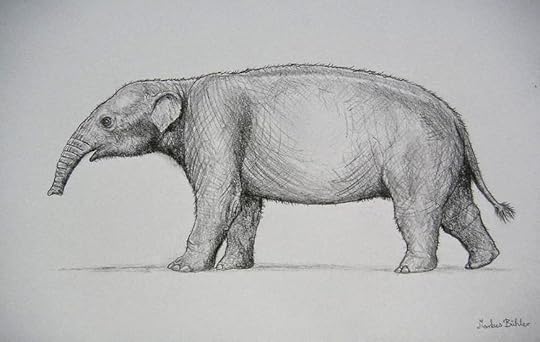 Artistic representation of the Congolese water elephant (© Markus Bühler)
Artistic representation of the Congolese water elephant (© Markus Bühler)Nevertheless, following publication of the Rothschild-Neuville paper, Le Petit was urged by Paris's National Museum of Natural History to pursue reports of a similar creature supposedly inhabiting Lake Chad in West Africa. Moreover, according to an article penned by Prof. Emile Trouessart in the 21 January 1911 issue of the French periodical La Nature, Le Petit would be accompanied by noted French zoologist Dr Emile Gromier, and the suggestion was that both the West African water elephant and the unknown originator of the Rothschild-Neuville mystery tusk may be a living deinothere.
Deinotheres were very large and highly unusual proboscideans known only from fossils, and characterised by their lower jaw's downward-curving pair of tusks. A deinothere had been discounted by Rothschild and Neuville in their paper as a plausible identity for their tusk's originator, but Heuvelmans did not discount a relatively small, amphibious, scientifically-undetected modern-day version out of hand when documenting the water elephant and the Rothschild-Neuville tusk in his books. As for the planned expedition to Lake Chad: I have been unable to discover whether Le Petit and Gromier ever did go there – but even if they did, they certainly didn't find a deinothere.
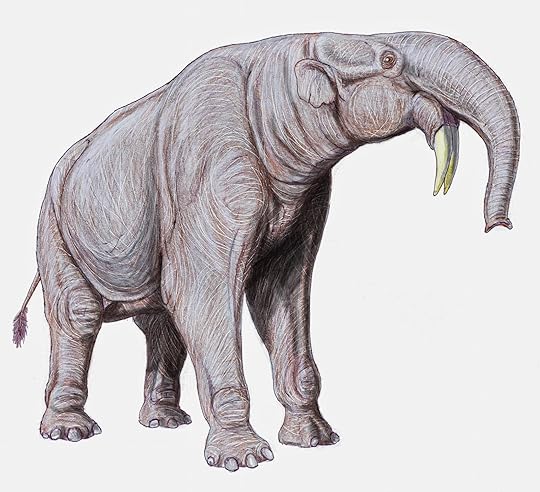 Reconstruction of a deinothere (© Dmitry Bogdanov/Wikipedia)
Reconstruction of a deinothere (© Dmitry Bogdanov/Wikipedia)Heuvelmans's second, privately-expressed opinion as to what creature the Rothschild-Neuville mystery tusk may have come from is even more radical than an undiscovered species of probiscidean. In a couple of emails sent to me by Michel Raynal during June 2014, Michel stated:
"In Heuvelmans's dossier on the tooth in Lausanne [the site of his Centre de Cryptozoologie], I noticed that there is an article on Afrochoerus, making me think that Heuvelmans believed that the "owner" of this tooth was more or less related to this fossil suid…
"Heuvelmans seemed to believe that it was a living Afrochoerus (he even told me, when I visited his "centre de cryptozoologie" in the 1980s, "je sais ce que c'est" = I know what it is).
"However, Afrochoerustusks are somewhat different."
They are indeed! In fact, the tusks of this African fossil pig once yielded a very notable controversy of their own.
Dating from the Pliocene epoch, Afrochoerus nicoliwas formally described in 1942 by celebrated palaeontologist Dr Louis Leakey from the famous Olduvai fossil deposits in Tanzania, with substantial additional finds excavated there in subsequent years. Its most striking features were the tusks originally uncovered with it, which were disproportionately long, and in early reconstructions, portraying it with these huge tusks pointing forward, it resembled a bizarre hybrid of wild pig and mastodont!
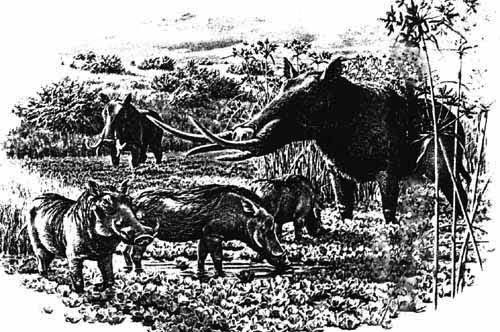 Erroneous restoration of Afrochoerusas an elephant-tusked giant warthog alongside modern-day warthogs (picture source unknown to me)
Erroneous restoration of Afrochoerusas an elephant-tusked giant warthog alongside modern-day warthogs (picture source unknown to me)In fact, this was quite prophetic, because palaeontologists now know that these tusks weren't suid (pig) tusks at all, but were in reality from Stegotetrabelodon – a genus of fossil gomphothere elephant! What had happened was that Afrochoerus had been based upon cranial remains of a bona fide fossil suid called Metridiochoerus compactus, the giant warthog, that had been discovered in close proximity to some tusks from Stegotetrabelodon, but which had been mistakenly assumed to be all from the same animal. In short, Afrochoerus – the extraordinary 'elephant pig' - was a non-existent composite, whereas the real tusks of M. compactus are nothing more than slightly larger versions of those possessed by modern-day warthogs, and project sideways, not forwards.
 Accurate reconstruction of Metridiochoerus(© Nobu Tamura/Wikipedia)
Accurate reconstruction of Metridiochoerus(© Nobu Tamura/Wikipedia)Consequently, although he apparently did not realise it, by favouring Afrochoerus as the identity of the Rothschild-Neuville tusk's owner at the time that he did, Heuvelmans was still supporting a proboscidean candidate (albeit a different one from the deinothere option), because the tusks to which he was comparing the latter mystery tusk were actually elephant tusks, not pig tusks.
But could this mystery tusk have derived from something other than a proboscidean? When I inspected the illustrations of it in the Rothschild-Neuville paper, images of walrus tusks immediately came to mind, even though the authors had discounted this possibility in their paper. True, there are certain discrepancies. The underside of walrus tusks have a single wide groove (just like the mystery tusk), but the upper side typically bears only a series of very fine longitudinal cracks of varying lengths. Also, walrus tusks are generally long and fairly straight, whereas if Rothschild and Neuville were correct in assuming that in its entirely their tusk would have been almost semi-circular in shape, this would also argue against a walrus tusk as its identity. So too does the dark brown patina exhibited by their tusk.
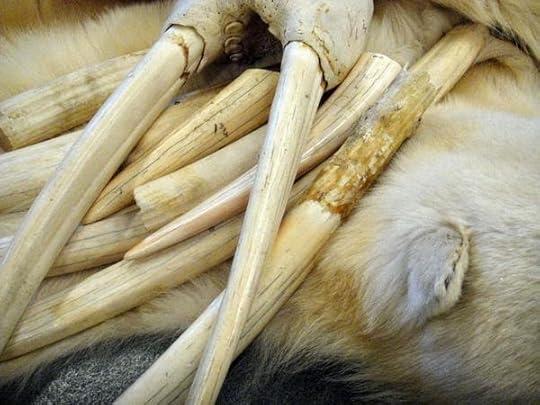 A batch of confiscated illegally-trafficked walrus tusks and tusked walrus skulls as well as some polar bear pelts (© US Fish and Wildlife Service)
A batch of confiscated illegally-trafficked walrus tusks and tusked walrus skulls as well as some polar bear pelts (© US Fish and Wildlife Service)However, I have seen photos of walrus tusks that do bear deep longitudinal grooves. Moreover, when I recently consulted Paolo Viscardi, the natural history curator at London's Horniman Museum, who also favours a walrus tusk as the best candidate for this enigmatic specimen, he stated:
"Walrus tusks can also be quite strongly curved and if they [Rothschild and Neuville] were extrapolating the curve and complete length based on pulp cavity extent beyond the sawn region, they may have been wildly out if they didn't have Walrus in mind, since Walrus cavity space is less extensive than what we see in something like an Elephant or Hippo."
Moreover, although the authors stated that it was not a fossil tusk, fossil walrus tusks do sometimes have a dark patina.
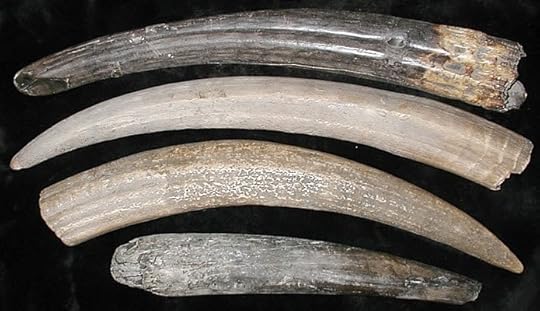 Walrus tusks, including fossil specimens displaying a very dark patina (click here for image source)
Walrus tusks, including fossil specimens displaying a very dark patina (click here for image source)But how would a walrus tusk have reached the ivory market of Addis Ababa anyway, bearing in mind that walruses only occur in the Arctic Ocean and the subarctic zones of the Atlantic and Pacific Oceans? Fellow Rothschild-Neuville tusk researcher Matt Salusbury, author of the book Pygmy Elephants (2013) in which this specimen is briefly referred to, suggested in an email to me of 30 June 2014 that whalers and immigrants from Scandinavia all en route to South Africa just prior to the tusk's appearance in Addis Ababa may have brought it with them.
Intriguingly, in South Africa's Orange Free State there are ancient bushman cave paintings that portray an unidentified creature bearing a remarkable resemblance to a walrus, and which has been colloquially dubbed the jungle walrus. The most famous one (portrayed below), which appeared in Rock-Paintings in South Africa (1930) by George William and Dorothea Bleek, can be found in a cave in Brakfontein Ridge, which was at one time (and perhaps still is?) contained within the grounds of a farm called 'La Belle France'. Just an imaginary beast, or a bona fide cryptid with possible relevance to the Rothschild-Neuville tusk?
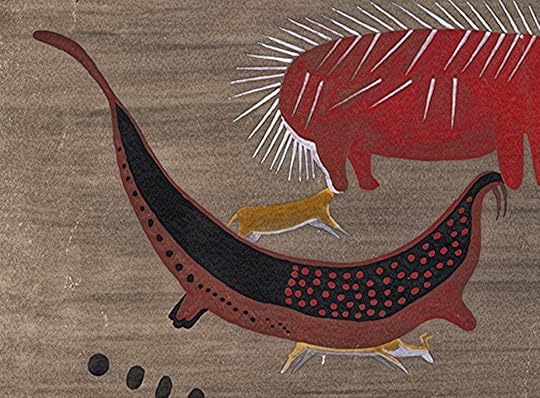 The mysterious 'jungle walrus' as depicted in a cave painting at Brakfontein Ridge, South Africa
The mysterious 'jungle walrus' as depicted in a cave painting at Brakfontein Ridge, South AfricaOf course, as noted earlier here, if only the Rothschild-Neuville tusk could be scientifically examined utilising the plethora of modern-day techniques readily available nowadays, its secrets would soon be teased out and laid bare. Yet as also noted earlier here, it was apparently lost long ago somewhere within the labyrinthine interior of its final resting place, the National Museum of Natural History in Paris – or was it?
Matt Salusbury has informed me (click also here ) that he is currently pursuing the tantalising possibility that the tusk may not have been mislaid but simply mislabelled, and is hoping to have its accession number rechecked and also those of comparable specimens there, such as walrus tusks, to determine whether this most mystifying specimen is actually hiding in plain sight - not lost at all, therefore, merely overlooked. He is also the accession logs at London's Natural History Museum, the Zoological Society of London, and the Tring Natural History Museum, too just in case the tusk was transferred from Paris to any of these English repositories. I wish Matt every success in his exciting undertaking, and very much hope to be able to announce here soon that the Rothschild-Neuville mystery tusk has indeed resurfaced – which would be a major success for contemporary cryptozoology. So watch this space!
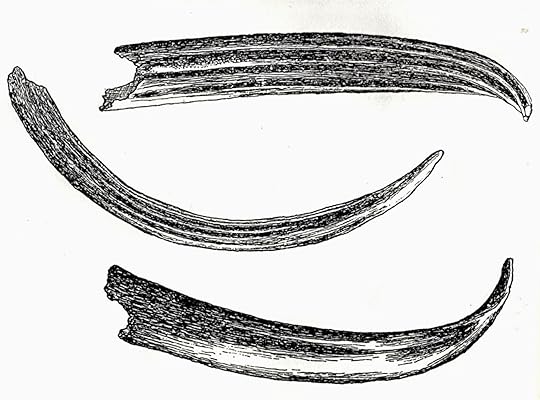 Line drawings from Heuvelmans's 1978 book based upon the photo of three views of the mystery tusk that appeared in the Rothschild-Neuville paper of 1907 (© Plon)
Line drawings from Heuvelmans's 1978 book based upon the photo of three views of the mystery tusk that appeared in the Rothschild-Neuville paper of 1907 (© Plon)
Published on July 02, 2014 16:03
June 26, 2014
WHITHER THE WATER ELEPHANT?
 Artistic representation of the Congolese water elephant (© Markus Bühler)
Artistic representation of the Congolese water elephant (© Markus Bühler)Whereas the African pygmy elephant has attracted appreciable interest and even more appreciable controversy, both within and beyond the cryptozoological community, a second contentious proboscidean reported from the Dark Continent has received far less attention, but in my view is much more intriguing. This latter cryptid is the so-called water elephant.
I first read about it in Dr Bernard Heuvelmans's classic crypto-tome On the Track of Unknown Animals (1958), and following some researches of my own I subsequently documented it in various of my books. The first was In Search of Prehistoric Survivors (1995). Here is what I wrote there:
What may be the most sensational example of a proboscidean prehistoric survivor - inasmuch as this one could still exist even today, yet still be eluding scientific discovery - made its Western debut in 1912, courtesy of an article by R.J. Cuninghame that appeared in the Journal of the East Africa and Uganda Natural History Society. In this, he referred to a Mr Le Petit, lately returned to Nairobi following five years of travelling within the French Congo [now the People's Republic of the Congo] - during which period he claimed to have twice encountered an extraordinary animal known to the Babuma natives as the ndgoko na maiji, or water elephant.
His first sighting, which occurred around June 1907 while journeying down the River Congo near the River Kassai's junction with it, was brief and featured only a single animal - seen swimming with head and neck above the water surface at a considerable distance away.
In contrast, his second encounter featured five specimens seen close by, on land. This took place in an area nowadays situated within the borders of Zaire, [now the Democratic Republic of Congo] i.e. the swampy country between Lake Leopold II (since renamed Lake Mai-Ndombe) and Lake Tumba, near to where the M'fini River finds its exit from the first of these lakes. After viewing the animals through binoculars while they stood about 400 yards away amid some tall grass, he shot one of them in the shoulder, but his native companions were unable to recover its body for him.
Le Petit described the water elephants as 6-8 ft tall at the shoulder, with relatively short legs whose feet had four toes apiece, a curved back, a smooth shiny skin like that of a hippo's and hairless too but darker, an elongate neck about twice the length of the African elephant's, plus ears that were similar in shape to those of that species but smaller in size. Most distinctive of all was its head, which was conspicuously long and ovoid in shape, which, together with its short, 2-ft-long trunk and lack of tusks, resembled that of a giant tapir.
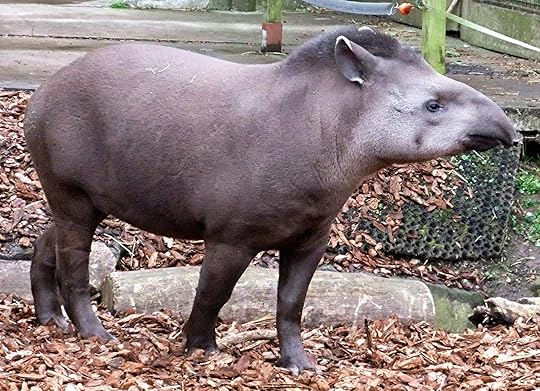 A Brazilian tapir (© Dr Karl Shuker)
A Brazilian tapir (© Dr Karl Shuker)According to the natives, the water elephant spends the daytime in deep water (where it is greatly feared by them, as it will sometimes rise upwards unexpectedly and capsize their canoes with its able if abbreviated trunk). Only at night does it emerge onto land, where it grazes upon rank grass. It is also very destructive to their nets and reed fish-traps, but is not a common species, and its distribution range is very restricted.
Confirming the natives' testimony, the five specimens under observation by Le Petit finally disappeared into deep water, and were not seen by him again.
If Le Petit's detailed description is accurate, the water elephant does not belong to either of today's known species of elephant. It has been likened by some to the deinotheres, an extinct proboscidean lineage whose members' diagnostic feature was a downward-curving lower jaw bearing a pair of long recurved tusks. The last known species survived until the late Pleistocene in Africa - but the water elephant bears little resemblance to these long-limbed forms with their curious lower jaw and tusks.
To my mind, it is much more similar to some of the most primitive proboscideans, such as Phiomia from Egypt's Oligocene, or even Moeritherium itself - the tiny tapir-like 'dawn elephant' from the late Eocene and early Oligocene, whose fossils are known from Egypt, Mali, and Senegal, and which is at the very base of the proboscidean evolutionary tree. Believed to have been a partially-aquatic swamp-dweller on account of its eyes' high, hippo-like position, if this beast had given rise to a dynasty of descendants that had become much larger but had retained their ancestor's lifestyle and its attendant morphological attributes, the result would most likely be an animal greatly resembling the Congolese water elephant.
The concept of such a beast persisting unknown to science in the 1990s may not find favour among many scientists, but the Congo region of tropical Africa has already unveiled more than enough major zoological surprises so far this century for anyone with a knowledge of these things to hesitate before discounting such a possibility entirely out of hand.
 Recent reconstruction of Moeritherium (© Luci Betti-Nash/Stony Brook University)
Recent reconstruction of Moeritherium (© Luci Betti-Nash/Stony Brook University)In 2008, a study of the composition of the teeth of Moeritheriumrevealed that its diet corresponded with the diet of mammals known to be aquatic, thereby confirming that it was indeed a water-dweller (click here for further details). Consequently, if it did give rise to a reclusive, modern-day lineage of morphologically and behaviourally conservative representatives, these could constitute a very plausible water elephant.
On 25 July 2002, I received a fascinating email from Canada-based field cryptozoologist Bill Gibbons concerning what may be the mysterious water elephant, which I included in one of my Alien Zoo columns for Fortean Timesand later in my book Karl Shuker's Alien Zoo: From the Pages of Fortean Times (2010). Here is what I wrote:
In mid-2003, Bill Gibbons, a veteran seeker of cryptozoological curiosities, plans to visit the Democratic Republic of Congo (formerly Zaire) with a Belgian helicopter company operating there, in order to pursue claims by the company's president and CEO that a military helicopter flying over Lake Tumba spied a herd of very strange-looking elephants that the helicopter's pilots thought may be the legendary water elephants. According to Bill, the producer of a French TV documentary company is keen to film the expedition, so we wish everyone associated with this project the best of luck, and await further developments with interest.
Sadly, however, the planned expedition never took place. So the precise nature of those strange-looking elephants of Lake Tumba remains unresolved.
 A second artistic representation of the Congolese water elephant (© Tim Morris)
A second artistic representation of the Congolese water elephant (© Tim Morris)Most recently, the water elephant saga was revisited by British cryptozoological investigator Matt Salusbury in his extremely comprehensive book Pygmy Elephants (2013). After reviewing the Le Petit sightings, he pondered whether, confronted by environmental crises within the past century or so, isolated elephant populations in Africa could have undergone dramatic and highly accelerated bouts of evolution and behavioural changes, yielding in the Congo region a much-modified nocturnal, aquatic form – the water elephant.
A fascinating concept, but if this cryptid has been described accurately in those sightings, its morphological differences from Africa's typical, predominantly terrestrial elephants are, I feel, much too profound and wide-ranging to have plausibly arisen via evolution in such a short space of time. Consequently, and always assuming of course that the water elephant really does exist, I still consider it much more likely that this distinctive creature constitutes a wholly discrete species in its own right, one that may well have diverged long ago from the lineage leading to Africa's modern-day Loxodonta species.
In his book's coverage of the water elephant, Matt also referred briefly to a perplexing tusk purchased in Addis Ababa, Ethiopia (then Abyssinia), during the opening years of the 20thCentury. This enigmatic but seemingly long-lost specimen, the Rothschild-Neuville mystery tusk, has fascinated me for many years, and after having researched it in considerable detail for some time, I shall very shortly be presenting an extensive account of its remarkable history exclusively here on ShukerNature – so watch this space!
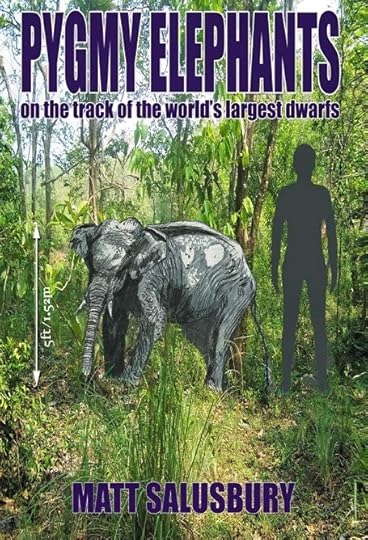 Pygmy Elephants
by Matt Salusbury (© Matt Salusbury/CFZ Press)
Pygmy Elephants
by Matt Salusbury (© Matt Salusbury/CFZ Press)
Published on June 26, 2014 14:58
June 25, 2014
THE FIRST NESSIE BOOK, AND A COMPREHENSIVE LOCH NESS MONSTER BIBLIOGRAPHY
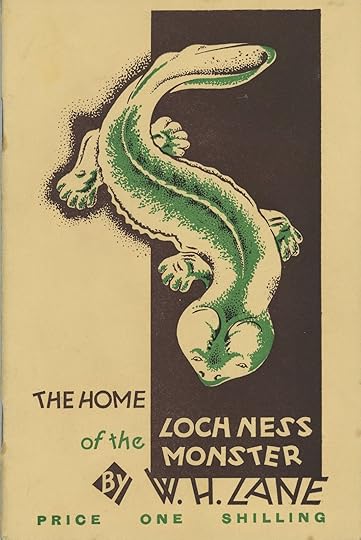 The Home of the
Loch
Ness
Monster
(image supplied to me by Errol Fuller)
The Home of the
Loch
Ness
Monster
(image supplied to me by Errol Fuller)It was 80 years ago this year when the pamphlet pictured above in this present ShukerNature blog post was published. A humble, unassuming little offering entitled The Home of the Loch Ness Monster, just 18 pages long, containing only a single illustration, and privately published by its author, a retired British army man named Lieutenant-Colonel William Horsburgh Lane who lived in a house on the shores of Loch Ness, it documented Lane's considered belief that the Loch Ness monster (LNM) may be a giant form of salamander. This particular zoological identity would be revisited and revitalised more than four decades later by Chicago University biochemist and veteran Nessie researcher Prof. Roy P. Mackal in his own much more detailed, highly-acclaimed study, The Monsters of Loch Ness (1976), which remains a standard work on the subject.
Conversely, Lane's very modest contribution to the LNM literature is all but forgotten today and exceedingly rare, making it much sought-after by Nessie aficionados – but not only because if its scarcity. What gives his pamphlet a unique, unassailable, and truly historic place within the cryptozoological canon, and the reason why I am celebrating today its publication in that long-ago year of 1934, is that it was the very first entire, stand-alone work (i.e. book, pamphlet, magazine, as opposed to merely an article in a magazine or a report in a newspaper) devoted exclusively to the LNM.
This, therefore, is where it all began – the trickle that became a stream that became a river that became a veritable ocean of Nessie-themed books published in the 80 years that have followed in the wake of Lane's pamphlet – and what a number there have been, as I am about to reveal.
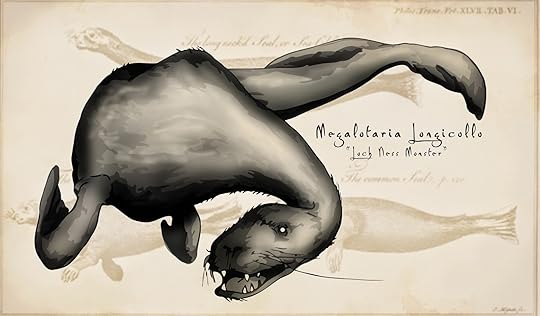 Nessie conceived as a long-necked seal (© Robert Elsmore)
Nessie conceived as a long-necked seal (© Robert Elsmore)I recently disclosed on Facebook that I am currently completing a compendium volume that brings together pretty well everything that I have ever written on the subject of the LNM – drawn from my books, articles, and ShukerNature blog posts, expanded and updated as required, and accompanied by a purposefully eclectic selection of illustrations, many of which have never been published before, including a number specially prepared for it by some very talented artist friends of mine.
Presently entitled Here's Nessie! A Monstrous Compendium From Loch Ness, it will also include what I am hoping will be the most comprehensive bibliography of Nessie-themed non-fiction books ever compiled. As with all such lists, however, no matter how comprehensive it may seem to be to its compiler, there will always be some entries that he will have overlooked, and especially so in relation to foreign–language (non-English) books.
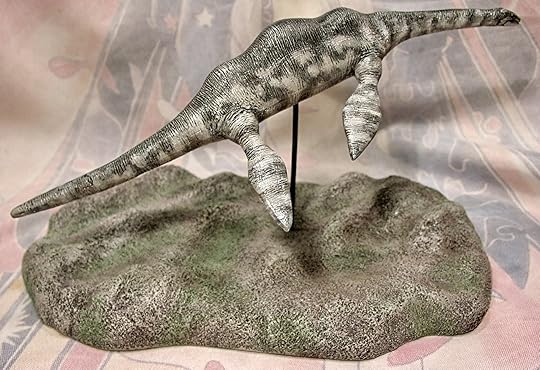 A model of Nessie conceived in classic plesiosaur mode (© Jeff Johnson)
A model of Nessie conceived in classic plesiosaur mode (© Jeff Johnson)Consequently, in the hope of plugging as many potential gaps in this bibliography as possible, I am presenting below the version that I have compiled so far, and would very greatly welcome any suggested additions from readers (and also any info regarding the few missing places of publication in the list). Please note, however, that I am not looking for books that only contain a single chapter or two on Nessie – all books included in this bibliography must be ones that are devoted entirely to the LNM (or to any other Scottish loch monsters), and they must also be works of non-fiction, not novels or other works of fiction. Thanks very much in advance for any assistance that you may be able to offer me, and enjoy the list!
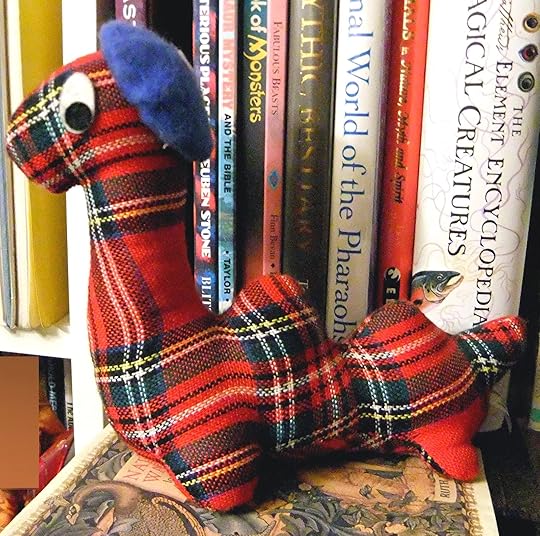 My very own tartan Nessie! (© Dr Karl Shuker)
My very own tartan Nessie! (© Dr Karl Shuker)My sincere thanks to Errol Fuller for originally bringing Lieut.-Col. Lane's pamphlet to my attention, and for very kindly supplying me with the image of its front cover that opens this ShukerNature blog post.
A BIBLIOGRAPHY OF NESSIE-THEMED NON-FICTION BOOKS
ANON., They Saw Nessie (Or Thought They Did!): Eye-Witness Sightings of the Monster Over the Years (Northern Books, from Famedram: Gartocharn, 1984).
ABELS, Harriette & SCHROEDER, Howard, The Loch Ness Monster (Crestwood House: New York, 1987).
AKINS, William, The Loch Ness Monster (Signet: New York, 1977).
ARMSTRONG, Edward, Sticking My Neck Out (Privately published: [no place of publication details], 1983).
BAUER, Henry H., The Enigma of Loch Ness: Making Sense of a Mystery (University of Illinois Press: Urbana, 1986).
BAUMANN, Elwood D., The Loch Ness Monster (Franklin Watts: New York, 1972).
BAXTER, Colin, The Loch Ness Monster (Colin Baxter Photography: Grantown on Spey, 2012).
BENDICK, Jeanne, The Mystery of the Loch Ness Monster (McGraw-Hill: London, 1976).
BERTON, Jean, Les Monstres du Loch Ness et d'Ailleurs (France-Empire: Paris, 1977).
BINNS, Ronald, The Loch Ness Mystery Solved (Open Books: Shepton Mallet, 1983).
BORDER, Rosemary, Loch Ness Monster (Macdonald Phoebus: London, 1979).
BRASSEY, Richard, Nessie the Loch Ness Monster (Orion: London, 2010).
BURTON, Maurice, The Elusive Monster: An Analysis of the Evidence From Loch Ness (Rupert Hart-Davis: London, 1961).
BYRNE, Gerald, Gestalt Forms of Loch Ness (JRP Ringler: Zurich, 2011).
CAMPBELL, Elizabeth M. & SOLOMON, David, The Search For Morag (Tom Stacey: London, 1972).
CAMPBELL, Steuart, The Loch Ness Monster: The Evidence (Aquarian: Wellingborough, 1986; rev. edit., Aberdeen University Press: London, 1991).
CARNEY, James, Loch Ness Monster (Colin Baxter Photography: Grantown on Spey, 2009).
CARRUTH, J.A., Loch Ness and Its Monster (Abbey Press: Fort Augustus, 1945).
CASSIE, R.L., The Monsters of Achanalt (2 vols) (D. Wyllie & Sons: Aberdeen, 1935-36).
COOK, D. & COOK, Y., The Great Monster Hunt: The Story of the Loch Ness Investigation(Grosset & Dunlap: New York, 1969).
CORNELL, James, The Monster of Loch Ness (Scholastic Book Services: New York, 1977).
DINSDALE, Angus, The Man Who Filmed Nessie (Hancock House: New York, 2013).
DINSDALE, Tim, Loch Ness Monster (Routledge & Kegan Paul: London, 1961; 4th edit., 1982).
DINSDALE, Tim, The Story of the Loch Ness Monster (Allan Wingate: London, 1973).
DINSDALE, Tim, Project Water Horse: The True Story of the Monster Quest at Loch Ness (Routledge & Kegan Paul: London, 1975).
FLITCROFT, Jean, The Loch Ness Monster [The Cryptid Files #1] (Darby Creek Publishing: Minneapolis, 2014).
GANTES, Rémy, Le Mystère du Loch Ness (Etudes Vivantes: Paris, 1979).
GIBSON, John A. & HEPPELL, David (Eds), Proceedings of the Symposium on the Loch Ness Monster: "The Search For Nessie in the 1980s" (Scottish Natural History Library: Foremount House, 1988).
GOULD, Rupert T., The Loch Ness Monster and Others (Geoffrey Bles: London, 1934).
GRIMSHAW, Roger & LESTER, Paul, The Meaning of the Loch Ness Monster (Birmingham University: Birmingham, 1976).
HAMILTON, W.D. & HUGHES, J., The Mysterious Monster of Loch Ness (Fort Augustus Abbey Press: Fort Augustus, 1934).
HANSEN, Kim M., Mysteriet om Nessie: Søslangen i Loch Ness (Gyldendal: Copenhagen, 1988).
HARMSWORTH, Tony, The Mysterious Monsters of Loch Ness (Precision Press: 1980).
HARMSWORTH, Tony, Loch Ness: The Monster (Peter Gray Ltd: Tillicoultry, 1985).
HARMSWORTH, Tony, Loch Ness, Nessie & Me: The Truth Revealed [vt Nessie Understood] (Harmsworth.net: Drumnadrochit, 2010).
HARRISON, Paul, The Encyclopedia of the Loch Ness Monster (Robert Hale: London, 1999).
HASTAIN, Ronald & WITCHELL, Nicholas, Loch Ness and the Monster: A Handbook For Tourists(J. Arthur Dixon: Inverness, 1971).
HAUF, Monika, Nessie – Das Ungeheur von Loch Ness (Bohmeier Verlag: Leipzig, 2003).
HILE, Lori, The Loch Ness Monster (Capstone Global Library: Oxford, 2013).
HOLIDAY, F.W., The Great Orm of Loch Ness: A Practical Inquiry Into the Nature and Habits of Water-Monsters (Faber & Faber: London, 1968).
JAMES, David, Loch Ness Investigation (Loch Ness Phenomena Investigation Bureau: London, 1968).
KALLEN, Stuart A., The Loch Ness Monster (Referencepoint Press: San Diego, 2008).
KIRKPATRICK, Betty, Nessie: The Legend of the Loch Ness Monster (Crombie Jardine Publishing: Cheam, 2005).
KLEIN, Martin, et al., Underwater Search at Loch Ness [Monograph No. 1] (Academy of Applied Science: Belmont, 1972).
LANE, W[illiam].H., The Home of the Loch Ness Monster (Moray Press: Edinburgh, 1934).
MacRAE, Jim, Loch Ness Monster Handbook (John G. Eccles: Inverness, 1974).
MACKAL, Roy P., The Monsters of Loch Ness (Macdonald and Janes: London, 1976).
MARTIN, David & BOYD, Alistair, Nessie: The Surgeon's Photograph Exposed (Martin and Boyd: East Burnet, 1999).
MEREDITH, Dennis L., The Search at Loch Ness: The Expedition of the New York Times and the Academy of Applied Science (Quadrangle: New York, 1977).
MILLER, Connie C., El Monstruo del Lago Ness: El Misterio Sin Resolver / The Loch Ness Monster: The Unsolved Mystery (Blazers Bilingual: North Mankato, 2009).
MUNRO, Donald J., Loch Ness Mystery (Privately published: [no place of publication details], 1937).
OUDEMANS, A.C., The Loch Ness Animal (Leyden: London, 1934).
OWEN, William, Loch Ness Revealing Its Monsters (Jarrold: Norwich, 1976).
OWEN, William, The Loch Ness Monster [vt Scotland's Loch Ness Monster] (Jarrold: Norwich, 1986).
PARKS, Peggy J., The Loch Ness Monster (KidHaven: Farmington Hills, 2006).
PERERA, Victor, The Loch Ness Monster Watchers (Capra Press: Santa Barbara, 1974).
PICKNETT, Lynn, The Loch Ness Monster (Pitkin Pictorials: Andover, 1993).
RINES, Robert H., et al., Underwater Search At Loch Ness (Academy of Applied Science: New York, 1972).
RUSSELL, Jessie & COHN, Ronald (Eds), Loch Ness Monster in Popular Culture [a hard-copy compilation of Wikipedia articles] (Bookvika Publishing: Moscow, 2012).
RUSSELL, Jessie & COHN, Ronald (Eds), Loch Ness Monster [a hard-copy compilation of Wikipedia articles] (Bookvika Publishing: Moscow, 2012).
SAN SOUCI, Robert D. (Ed.), The Loch Ness Monster: Opposing Viewpoints (Greenhaven Press: San Diego, 1989).
SCHACH, David, The Loch Ness Monster (Torque Books: Minneapolis, 2010).
SEARLE, Frank, Nessie: Seven Years in Search of the Monster (Coronet: London, 1976).
SEARLE, Frank, The Story of Loch Ness (John Eccles: Inverness, 1977).
SEARLE, Frank, Around Loch Ness: A Handbook For Nessie Hunters (John Eccles: Inverness, 1977).
SENSICAL, Benjamin, Loch Ness: An Explanation (Privately published: [no place of publication details], 1982).
SHINE, Adrian, Loch Ness? (Loch Ness Project: Drumnadrochit, 2006).
SHUKER, Karl P.N., Here's Nessie! A Monstrous Compendium From Loch Ness (CFZ Press: Bideford, 2014).
SIEVERT, Terri, The Unsolved Mystery of the Loch Ness Monster (First Fact Books: North Mankato, 2013).
SNYDER, Gerald S., Is There a Loch Ness Monster? The Search For a Legend (Julian Messner: New York, 1977).
THORNE, Ian, The Loch Ness Monster (Crestwood House: New York, 1978).
TROUPE, Thomas K., The Legend of the Loch Ness Monster (Picture Window Books: North Mankato, 2011).
VIBE, Palle, Gaden I Loch Ness (Rhodos: Copenhagen, 1970).
WALLACE, Holly, The Mystery of the Loch Ness Monster (Capstone Global Library: Oxford, 2006).
WATSON, Roland, The Water Horses of Loch Ness (CreateSpace: London, 2011).
WELSH, Lily (Ed.), Monsters and Myths: Loch Ness and the Monster [a hard-copy compilation of Wikipedia articles] (Webster's Digital Services: 2010).
WHYTE, Constance, The Loch Ness Monster (Headley Brothers: London, 1951).
WHYTE, Constance, More Than a Legend: The Story of the Loch Ness Monster(Hamish Hamilton: London, 1957; rev. 1961).
WITCHELL, Nicholas, The Loch Ness Story (Terence Dalton: Lavenham, 1974; 3rd edit., Corgi Books: London, 1989).
WITCHELL, Nicholas, Loch Ness and the Monster (J. Arthur Dixon: Newport, 1975).
 My little collection of Nessie figurines (© Dr Karl Shuker)
My little collection of Nessie figurines (© Dr Karl Shuker)This Loch Ness monster bibliography is excerpted from my forthcoming book, Here's Nessie! A Monstrous Compendium from Loch Ness , due to be published later this year by CFZ Press.
Published on June 25, 2014 11:33
June 19, 2014
NYOLS AND NET-NETS AND BITARRS, OH MY! - ON THE TRACK OF AUSTRALIA'S ELUSIVE (OR ILLUSIVE?) MINI-MEN
st1\:*{behavior:url(#ieooui) }
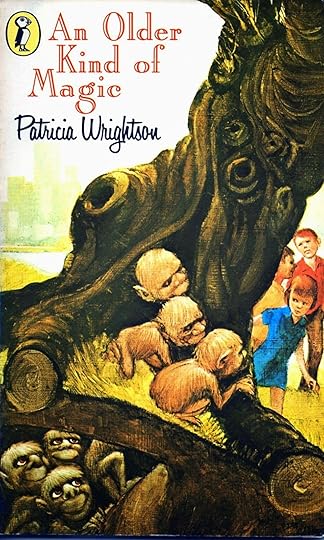 My copy of Patricia Wrightson's famous children's novel An Older Kind of Magic(1972), in which I first learnt of nyols, net-nets, and several other examples of Australia's ancient, traditional mini-humanoid entities that she incorporated into her story; its front cover illustration in this Puffin paperback edition features nyols and net-nets (cover illustration © Jack Newnham/Puffin Books)
My copy of Patricia Wrightson's famous children's novel An Older Kind of Magic(1972), in which I first learnt of nyols, net-nets, and several other examples of Australia's ancient, traditional mini-humanoid entities that she incorporated into her story; its front cover illustration in this Puffin paperback edition features nyols and net-nets (cover illustration © Jack Newnham/Puffin Books)"Beneath the earth are older things than perhaps we understand: as old as the ground in which they live, and part of it. Every so often, when the time is right, they appear again above the earth to visit the world that once was theirs alone."
Patricia Wrightson – An Older Kind of Magic
The following ShukerNature article was originally inspired in no small way by the above book, which was a favourite of mine as a youngster.
According to the traditional beliefs of the native Australian (Aboriginal) peoples, Alcheringa - the Dreamtime - was the Time of Creation. As described by Mudrooroo Nyoongah in Aboriginal Mythology (1994), it "symbolizes that all life to the aboriginal peoples is part of one interconnected system, one vast network of relationships which came into existence with the stirring of the great eternal archetypes, the spirit ancestors who emerged during the Dreamtime".
In the Dreamtime, all of today's Australian animals existed in human form, as kangaroo-men, emu-men, koala-men, even starfish-men, and so forth, only later transforming into animals. However, there were also many much stranger beings - some monstrous, some humanoid or part-humanoid. These are discounted as fictitious by westerners and are largely unknown outside Australia. However, this vast continent's indigenous nations firmly believe that they still exist even today, and can occasionally be seen - if you know where, and how, to look for them...
THE SHADOW PEOPLE - FROM NYOL TO NINGAUI
According to the Wiradjuri people of New South Wales's central west, the elders always tell their children to count their shadows when playing, and be sure to tell them if they count an extra one - for that will surely mean a winambuu or a yuuri is playing with them.
Roughly equivalent to the Little People elsewhere in the world, the winambuu and yuuri (pronounced ‘yawri’) resemble small dwarf-like beings, only 3 ft tall and hairy. They can be benevolent or antagonistic, depending upon their prevailing mood and the manner in which they are treated by humans, often acting as tricksters, but serving as guardians of certain localities too. Also spoken of in New South Wales, but this time by the Gumbangirr people, are the bitarr, who derive great pleasure from playing with Gumbangirr children.
 An antagonistic human bamboozled by mischievous nyols, as illustrated in Patricia Wrightson's children's novel An Older Kind of Magic (illustration © Noela Young/Puffin Books)
An antagonistic human bamboozled by mischievous nyols, as illustrated in Patricia Wrightson's children's novel An Older Kind of Magic (illustration © Noela Young/Puffin Books)Concealed to all but the sharpest of native eyes in the eastern Australian state of Victoria as they play amid the shadows of dusk are the nyols. These small humanoid entities have stony-grey skin, and spend their daytime underground like Antipodean gnomes, inhabiting subterranean caverns in deep rocks. According to Kurnai tradition, they can be good or evil, and will sometimes steal the memory of humans that they encounter.
The net-nets also hail from Victoria and inhabit rocky caverns, but mostly above-ground, and have brown skin with long claws instead of nails. In some ways the Australian counterpart of leprechauns, net-nets tend to make nuisances of themselves with humans – stealing things, and deceiving human hunters. Further details of nyols and net-nets can be found in Massola Aldo's book Bunjil's Cave (1968) – a fascinating collection of traditional folklore drawn from Victoria's Aboriginal nations.
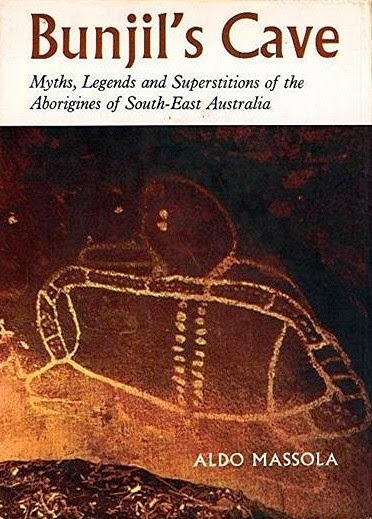 Bunjil's Cave
(© Massola Aldo/Lansdowne Press)
Bunjil's Cave
(© Massola Aldo/Lansdowne Press)Ask any zoologist what a ningaui is, and if they are well-informed they will reply that it is a tiny shrew-like form of Australian marsupial mouse, the first known species of which were formally documented by science as recently as 1975.
To the native Australian Tiwi people, conversely, ningauis are much more ancient, familiar entities - and it is from these that the ningaui marsupial mice derive their name. In traditional Tiwi Aboriginal lore, the ningauis (‘short ghosts’) comprise a hairy race of 2-ft-tall Dreamtime beings with short feet and a passion for eating raw food, as they have no knowledge of how to make fire. They are active only at night, and inhabit dense mangrove swamps on Melville Island, off Australia's northern coast. The ningauis assisted in the earliest Kulama ceremonies, which are initiation rites into religious cults and feature the special preparation for eating of an otherwise poisonous yam known as the kulama.
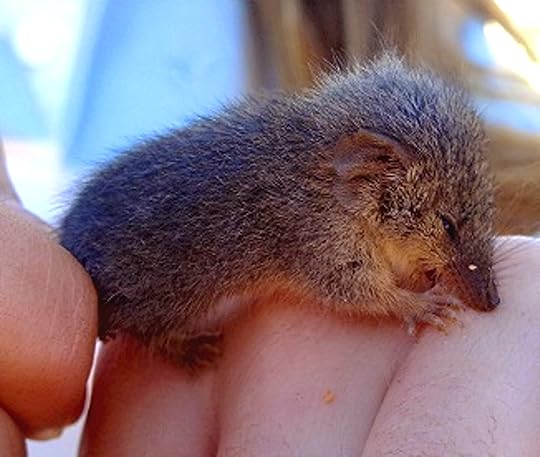 A southern ningaui Ningaui yvonneae, one of three species of marsupial mouse named after the mythical humanoid ningauis (© miss.chelle.13/Wikipedia)
A southern ningaui Ningaui yvonneae, one of three species of marsupial mouse named after the mythical humanoid ningauis (© miss.chelle.13/Wikipedia)JUNJUDDIS AND THE GREY PEOPLE
Some investigators claim that there are undiscovered tribes of Aboriginal pygmies inhabiting remote regions of Australia, such as the Cairns rainforest, smaller than the short-statured tribes already known to have once existed there.
Amateur historian Frank O’Rourke of Bloomfield, Queensland, has been actively researching reports of pygmies in the Cairns outback for many years, having amassed records dating back to the times of first European settlement. He has even unearthed some long-forgotten photographs from the 1880s depicting extremely small Aboriginal people little more than 3 ft tall, from the Bloomfield region, found among documents housed in Brisbane’s John Oxley Library.
Moreover, fellow Queensland investigator Grahame Walsh has long been on the prowl through the rugged bush terrain around Carnarvon Gorge in search of junjuddis – very small ape-like entities only 3 ft or so tall, with hairy humanoid bodies but long ape-like arms, and a somewhat odiferous presence. A former Carnarvon National Parks and Wildlife officer, Walsh has no doubt that these weird mini-beings are real, and has even encountered their tracks, preserved by him afterwards as plaster casts – which he likens to the footprints that a 5-year-old child would make. During the 1970s, there was a spate of junjuddi sightings, but fewer in recent times, because people rarely traverse the wildernesses nowadays. Similar pygmies are claimed to exist in the mountains of Arnhem Land north of the Roper River in the Northern Territory, where they are called the burgingin.
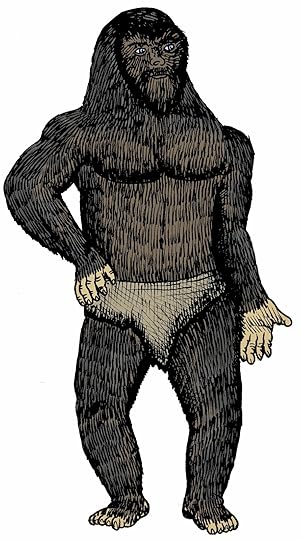 A junjuddi (© Tim Morris)
A junjuddi (© Tim Morris)In late October 2002, announcing her then-forthcoming Quest Trek 2002 expedition in search of putative surviving thylacoleonids or marsupial lions in the Flinders Range region of South Australia, Aussie cryptozoologist Debbie Hynes also referred to a much less familiar crypto-subject, the Grey People. This is the name given by Westerners here to a mysterious race of very small, furry, black-skinned humanoids, which walk upright but are only 3-4.5 ft tall, with sloping brows, pronounced eyebrow ridges, and ape-like faces. Long spoken of in the local desert Aboriginals’ legends, they also have their own Aboriginal name, and they appear in ancient rock art, but are still being reported today too.
According to Debbie, in 2001 an American back-packer startled one of these beings when he returned to his camp and discovered it stealing his belongings. Debbie’s own guide for her expedition was a trapper back in the 1950s and 1960s, who mentioned to her that on one occasion he’d been followed by some Grey People, hoping to steal rabbits from his traps, and during that trip he’d found one sprung trap containing a fresh human-like fingernail but no bigger than the nail of a young child’s little finger; he assumes that in springing it, a hand of one such entity had been caught by the trap.
How extraordinary it would be if the preternatural gnomes and dwarfs of Australia’s Dreamtime proved to be bona fide (albeit exceedingly elusive) pygmy tribes still evading formal scientific recognition. After all, certain strange Dreamtime entities, once deemed entirely fabulous, have since been shown to have been inspired by erstwhile native species of animal – so perhaps Australia’s s shadowy Little People may also have an origin in reality instead of reverie.
STICK MEN AND NIGHT SPIRITS
Stranger in form than the Aboriginal Little People are the various 'stick beings' of Dreamtime tradition. They include the desert-dwelling mimi of Arnhem Land in the Northern Territory. Said to have sported human form before the coming of the first Aboriginals, these spirit people are nowadays tall but exceptionally thin, resembling animated sticks, and are thus able to live inside the narrowest rocky crevasses and amid the densest bush or scrub. Many ancient but finely-executed rock paintings exist in this region that depict mimi, portraying them dancing, running, hunting various creatures, and are usually painted only in red ochre. According to Aboriginal lore, these are the work of the mimi themselves, i.e. self portraits. Furthermore, it is the mimi who supposedly taught the first Aboriginal people in northern Australia how to paint, as well as how to hunt and cook kangaroos and other animals.
Nevertheless, mimi are not always benevolent, and today they are feared by native people here, because their diet not only includes yams, of which they are exceedingly fond, but also any unwary humans that they may choose to seize with their skeletal hands, especially if provoked. Consequently, when passing through mimi-frequented territory, it is best to choose a windy day. This is because these weird-looking entities are frightened to venture forth in such weather, in case their fragile thread-like necks should be broken by the blustery power of the wind.
 A mimi in Aboriginal art (click
here
for my source of this image)
A mimi in Aboriginal art (click
here
for my source of this image)An even more malevolent race of stick beings are the vampire-like gurumukas, frequenting Groote Eylandt ('Great Island') in the Gulf of Carpentaria. These spindly nocturnal spirits have long projecting teeth, and if one of them should encounter a native Australian walking alone at night, it will bite the back of his neck, causing him to die in great pain unless rescued and swiftly tended to by a medicine man.
Equally malign are the nadubi of Arnhem Land, which are equipped with barbed stingray-like spines projecting from their elbows and knees. These bizarre spirit beings also seek solitary humans, and if they should find one and succeed in stabbing a spine into his body, he will surely die unless the spine is removed immediately by a wise shaman.
 A quinkin (© Tim Morris)
A quinkin (© Tim Morris)The largest and most famous of all spirit stick men, however, are the quinkin, from Queensland's Cape York Peninsula. These giant entities represent the embodiment of human lust - on account of their excessively large (and often grotesquely-shaped) male sexual organs. As with the mimi, there are many prehistoric cave paintings depicting the quinkin, in Cape York's Laura rock galleries.
NEITHER MAN NOR BEAST - CLOSE ENCOUNTERS OF THE SPOOKY KIND
The most frightening monsters in any culture are those that appear partly, but not entirely, human, and this is certainly true of the Australian Dreamtime beings.
The yara-ma-yha-who is a truly grotesque spirit entity, which has red hair, red skin, huge eyes, lives in fig trees, and superficially resembles a small, toothless old man. However, it is also equipped with some decidedly non-human attributes. There are suckers on the ends of its long fingers and toes through which it sucks the blood of any unsuspecting human that it can leap upon. Its incredibly flexible jaws are not hinged at the back, hence they can open so wide that it can swallow its human victim whole. And its massive stomach is so obese that it can readily hold its victim until he is totally digested! Sometimes, however, it does not digest its victim, but regurgitates him and reswallows him several times. Each time, its victim becomes smaller, and redder - until at last he has transformed into a yara-ma-yha-who.
 A yara-ma-yha-who (© Tim Morris)
A yara-ma-yha-who (© Tim Morris)The Aboriginals' ancestors travelled to Australia from southern Asia, which is home to several species of small, tree-dwelling, carnivorous/insectivorous primate known as tarsiers. Although harmless to humans, tarsiers do have enormous eyes and suckers on the ends of their fingers, and can look very unnerving at times! Cryptozoologists have speculated that perhaps the yara-ma-yha-who is a distorted, much-exaggerated folk memory of a tarsier, passed down from the Australian Aboriginals' Asian ancestors.
 Tarsiers can look very unnerving at times, especially when aggressive like this particular individual. So don't make them angry – you wouldn't like them when they're angry! (© Serafin "Jun" Ramos, Jr/Wikipedia)
Tarsiers can look very unnerving at times, especially when aggressive like this particular individual. So don't make them angry – you wouldn't like them when they're angry! (© Serafin "Jun" Ramos, Jr/Wikipedia)Similarly, just as there are many reports in southern Asia of giant bat-like entities - referred to in Java, for instance, as the ahool, and in Seram as the orang bati ('flying man') - native Australian lore also contains legends of veritable 'bat-men', known as the keen-keeng. Long ago, this tribe of half-humans inhabited a huge cave on the Western Australian border, and worshipped a fire god, to whom they sacrificed living humans. In their normal state, the keen-keeng were outwardly human, which greatly assisted them when luring victims to their cave, but they could be distinguished by their hands, which lacked the first two fingers of human hands. Their greatest difference, however, was their magical aerial ability - for whenever they chose, the keen-keeng could raise their arms above their heads and instantly transform them into a pair of large, powerful wings. This talent enabled these eerie entities to travel great distances when seeking potential sacrifice victims, but they were finally destroyed by two wise medicine men known as the Winjarning brothers.
 A keen-keeng abducting the Winjarning brothers, as depicted by Alice Woodward upon the front cover of the 2003 Courier Dover edition of W. Ramsay Smith's classic book Myths and Legends of the Australian Aborigines, first published in 1932 (© Alice Woodward/Courier Dover Publications)
A keen-keeng abducting the Winjarning brothers, as depicted by Alice Woodward upon the front cover of the 2003 Courier Dover edition of W. Ramsay Smith's classic book Myths and Legends of the Australian Aborigines, first published in 1932 (© Alice Woodward/Courier Dover Publications)Another semi-human monster vanquished by the Winjarnings was Cheeroonear, who lived with his wife and dogs in a dense forest near Nullarbor Plain, which overlaps the present-day Australian states of South Australia and Western Australia. According to William Ramsey Smith's Myths and Legends of the Australian Aboriginals (1930), Cheeroonear was:
"...a being with ears and face like a dog, but without a chin. From the lower jaw there hung a flesh-like bag, shaped like the pouch of a pelican, and leading into the stomach. The ribs did not join in the centre to form a chest with one cavity, but were arranged so as to make two compartments. The compartment on the left side contained the lungs, and the one on the right side held the heart and its vessels, leaving the throat like a wide sack between the two, so that when it held water or food it looked like a tube...He stood eight feet high. His arms reached below his knees to his ankles. When he stretched or opened his fingers he could touch the ground. He could pick up objects from the ground without stooping."
Responsible for the disappearance of several people from human camps around the edge of the forest, Cheeroonear was finally ambushed by the Winjarnings, with the assistance of a dense fog sent by the God of the Dewdrops, and duly slain with their warrior boomerangs.
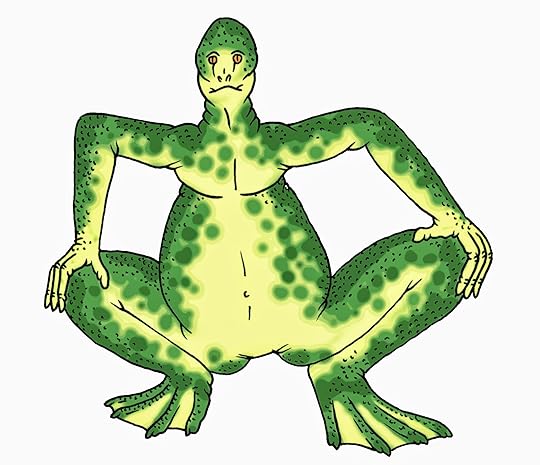 A potkoorok (© Tim Morris)
A potkoorok (© Tim Morris)Happily, not all semi-human Dreamtime entities are dangerous or evil. The potkoorok of Victoria, for instance, is a shy, inoffensive man-frog, resembling a small human but with a wet pear-shaped body, long mobile fingers, and huge webbed feet. Highly reclusive, it actively hides away from human eyes in deep pools and rivers.
Nyol, net-net, and ningaui, yuuri and yara-ma-yha-who, quinkin, mimi, potkoorok, and many more too - distant denizens of the Dreaming, but for whom there no longer seems to be any time in today's 'civilised', westernised world. Yet time is never still, and one day theirs too may come again.
This ShukerNature article is a greatly-expanded, updated version of a chapter section from my book Dr Shuker's Casebook: In Pursuit of Marvels and Mysteries (CFZ Press: Bideford, 2008).

Published on June 19, 2014 11:51
June 17, 2014
IS IT A BIRD? IS IT A PLANE? NO - IT'S BATSQUATCH!
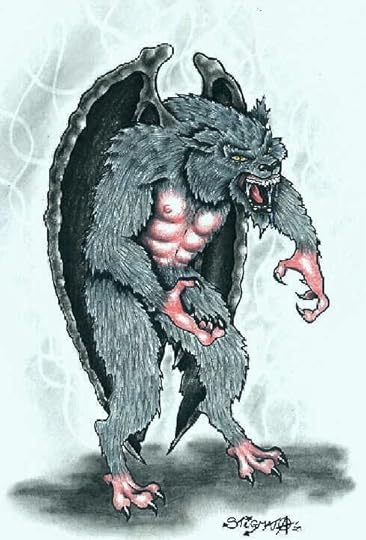 Spectacular rendition of batsquatch by tattoo artist and friend Gary Stanley aka Stigmata, originally prepared by him specifically for a magazine article of mine during the late 1990s – cheers, Gaz! (© Gary Stanley/Stigmata)
Spectacular rendition of batsquatch by tattoo artist and friend Gary Stanley aka Stigmata, originally prepared by him specifically for a magazine article of mine during the late 1990s – cheers, Gaz! (© Gary Stanley/Stigmata)Twenty years ago this year, one of the most bizarre winged entities ever reported made its first – and seemingly only – appearance, at least as far as the media headlines were concerned, but do any ShukerNature readers have additional information? As revealed, here, moreover, it may not have been entirely unprecedented.
It was 9.30 am on 19 April 1994, and 18-year-old high school student Brian Canfield was driving a truck from Buckley to his home at Camp One in the foothills of Mount Rainier, above Lake Kapowsinin Washington State, USA, when for no apparent reason his truck abruptly came to a halt. Then, about 30 ft ahead, descending onto the road with a sizeable thud, appeared a creature of nightmare!
Standing perfectly still on its hind legs, at least 9 fttall, and covered in bluish fur, it had a wolf-like face, yellow eyes with half-moon pupils, tufted ears, a large mouth well supplied with sharp white teeth (but no fangs), bird-like feet, powerful arms, and fingered hands. It also had a pair of huge wings, which lay folded behind its broad shoulders as this monstrous being gazed at the unbelieving trucker for several minutes in a terrifying face-off.
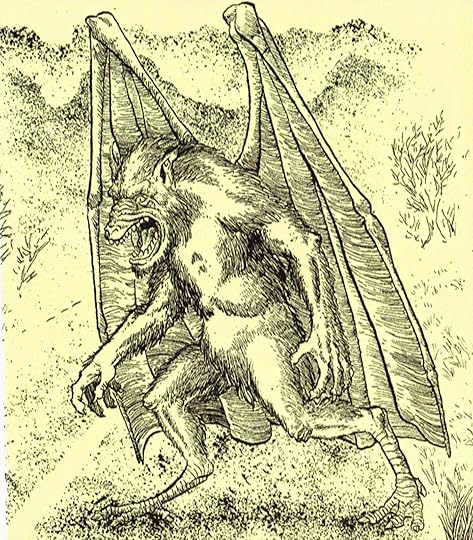 A second wonderful illustration of batsquatch by another very talented friend of mine, Swedish artist/film-maker Richard Svensson (© Richard Svensson)
A second wonderful illustration of batsquatch by another very talented friend of mine, Swedish artist/film-maker Richard Svensson (© Richard Svensson)Canfield's macabre confrontation finally ended when his astonishing visitor began twitching its fingers, then unfolded its wings, which were so enormous that they spanned the entire width of the road, and slowly took off into the air - stirring up such extensive turbulence before soaring away towards Mount Rainierthat Canfield's truck rocked and swayed. Once it had departed, his truck inexplicably came alive again, enabling him to drive home.
Later that day, still greatly frightened but this time accompanied by his mother and a neighbour, Canfield returned to the location of his incredible encounter. He hoped to find something that could provide physical proof of his story's veracity, but was unable to do so. Notwithstanding this, his reputation for honesty and abstemious lifestyle were such that no-one acquainted with him had any doubt that he was telling the truth. Even newspaper columnist C.R. Roberts, who interviewed him in the Tacoma News Tribune on 1 May (following an earlier article regarding batsquatch in that same newspaper on 24 April), was convinced of his sincerity.
As for the amazing creature seen by him, its surrealistic similarity to a bigfoot (sasquatch) incongruously sprouting a pair of bat-like wings was sufficient for the media to dub it 'batsquatch' - a memorable name for a truly unforgettable entity.
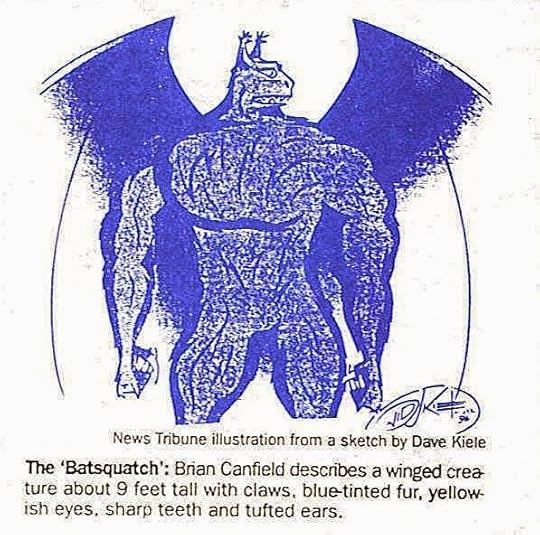
Sketch of batsquatch by artist Dave Kiele, based upon Brian Canfield's description, which appeared in the Tacoma News Tribune on 24 April 1994 (© Dave Kiele/Tacoma News Tribune)
Although no further reports of batsquatch appear to have emerged, when first reading Canfield's description of it I thought of another remarkable encounter on file, which Geoffrey Hodson claimed to have experienced while visiting England's Lake District in June 1922. He later documented it in his book Fairies at Work and at Play (1925):
"My first impression was of a huge, brilliant crimson, bat-like thing, which fixed a pair of burning eyes upon me. The form was not concentrated into the true human shape, but was somehow spread out like a bat with a human face and eyes, and with wings outstretched over the mountainside. As soon as it felt itself to be observed it flashed into its proper shape, as if to confront us, fixed its piercing eyes upon us, and then sank into the hillside and disappeared. When first seen its aura must have covered several hundred feet of space, but in a later appearance, in which it again showed itself, the actual form was probably ten to twelve feet high."
Hodson was a Theosophist, and believed that the above entity was a deva - an elemental nature spirit. Devas advising and assisting the human workers at Findhorn in Scotland and Perelandra in the U.S.A. were deemed to be responsible for the astonishingly successful cultivation of extra-large vegetables and flowers in the gardens of these experimental spiritual communities, despite the poor quality of the soil and the adverse climate.
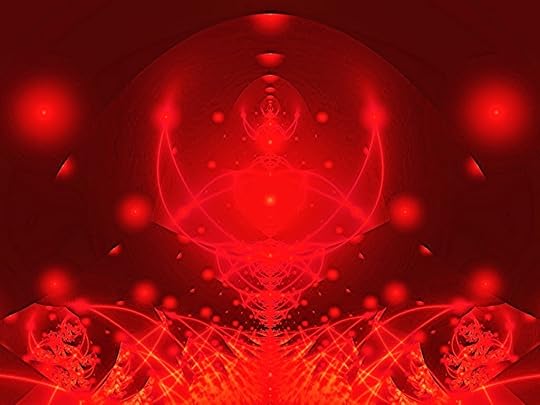 Abstract deva
Abstract devaCould batsquatch have been a deva? In spite of its daunting appearance, it made no attempt to harm or even threaten Canfield, merely observing him for a time before disappearing, just like the being observed by Hodson in the Lake District.
Also worth recalling here is an episode recounted to me on 9 October 2010 by New Zealand colleague Mark Phillipps, but whose source he was unable to recollect (click here for more details regarding this and also another strange entity mentioned to me by Mark):
"If I remember correctly, there were two men walking along some rough coastal cliffs (it may have been in Britain but I cannot be sure) when they came over a rise and saw a very large orange bat-like creature sunning itself on the rocks just above the water line.
"I believe they described it as being a good thirty or forty feet across."
If this account is familiar to anyone, I'd greatly appreciate receiving details of its source, which I will also pass on to Mark – thanks very much.
This ShukerNature post is excerpted and expanded from my book Mysteries of Planet Earth (1999).

Published on June 17, 2014 07:09
June 14, 2014
GLOWING MUDSKIPPERS AND FLASHLIGHT FROGS – TWO BIOLUMINESCENT MYSTERY BEASTS?
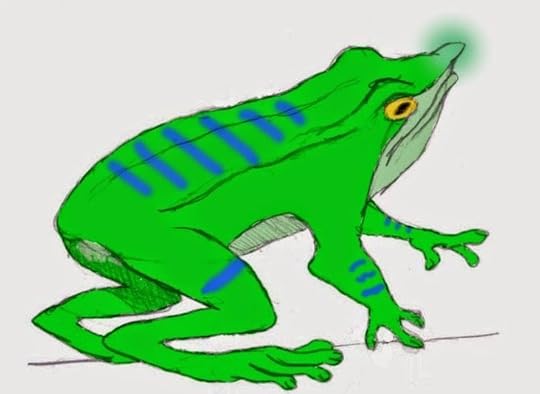 Artistic representation of the unidentified flashlight frog (© Connor Lachmanec, aka TheMorlock on Deviantart.com)
Artistic representation of the unidentified flashlight frog (© Connor Lachmanec, aka TheMorlock on Deviantart.com)Bioluminescence is the emission of light by certain life forms. These include many known species of bacteria, fungi, protozoans, invertebrates, and fishes, but there are also several controversial examples, including the following couple – both of which may constitute remarkable new species still undescribed by science.
SEEING RED IN SERAM
One evening in June 1986, while working on the small eastern Indonesian island of Seram (Ceram) for the VSO, tropical agriculturalist Tyson Hughes spied some very eyecatching, unidentified fishes in a river.
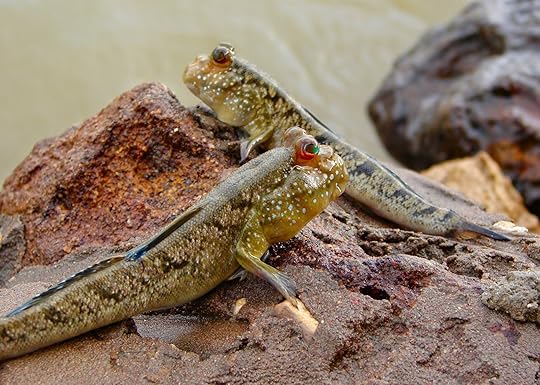 Some typical, non-bioluminescent mudskippers (© Bjørn Christian Tørrissen/Wikipedia)
Some typical, non-bioluminescent mudskippers (© Bjørn Christian Tørrissen/Wikipedia)They resembled the familiar 'fish-out-of-water' mudskippers in general size and shape. However, quite apart from inhabiting freshwater rather than intertidal habitats, these curious fishes encountered by Tyson further differed from all known species of mudskipper by emitting a bright, pulsating red light.
 Artistic representation of Seram's mudskipper-like glowing mystery fish (© Ursulav/New Cryptozoology Wikia)
Artistic representation of Seram's mudskipper-like glowing mystery fish (© Ursulav/New Cryptozoology Wikia)Tyson earnestly attempted to catch one of them, but failed to do so.
THE FROG WITH THE LUMINOUS NOSE
In one of his famous nonsense poems, Edward Lear wrote about the dong with the luminous nose, whereas the following cryptid was apparently a frog with a similar attribute, yet was anything but nonsensical.
 Swedish artist Richard Svensson's wonderful interpretation of Edward Lear's dong with the luminous nose (© Richard Svensson)
Swedish artist Richard Svensson's wonderful interpretation of Edward Lear's dong with the luminous nose (© Richard Svensson)While visiting an animal fair at Newton Abbot in Devon, England, in June 1997, Devon-based CFZ founder Jonathan Downes noticed a cage containing some tree frogs, reputedly from northern Cameroon in western Africa and priced at £25 per frog. Jon was intrigued by these creatures, which each bore a blue spot on its snout, because he could not identify their species. He was even more intrigued when informed by their vendor that the blue spot on their snout glowed in the dark like a flashlight, possibly to attract insects as prey.
 A typical green tree frog, conspicuously lacking the flashlight frog's unique glowing snout spot (public domain – for my source of it, click
here
)
A typical green tree frog, conspicuously lacking the flashlight frog's unique glowing snout spot (public domain – for my source of it, click
here
)Nevertheless, Jon felt that £25 was too expensive a sum, so he resisted the temptation to buy one - a decision that he would soon bitterly regret. For when he later described these curious flashlight frogs to various herpetological colleagues, he was shocked to discover that there is no species of frog known to science that can glow. Consequently, he had missed the opportunity to purchase a specimen of what might not only be a completely unknown species, but also exhibit a talent unique even among the world's considerably varied array of frogs.
This ShukerNature blog post is excerpted in slightly expanded form from my book Mysteries of Planet Earth (1999) – the first publication ever to document either of these mystery beasts (contrary to various erroneous online claims, the flashlight frog did not appear in one of my earlier books, From Flying Toads To Snakes With Wings (1997)). Today, 15 years later, both of them are still unidentified and unexamined by science - so if anyone reading this blog post (especially anyone with knowledge of or firsthand experience in the exotic pet trade) has any additional information concerning these or any other mysterious glowing creatures, I'd welcome any details that you'd like to post here.
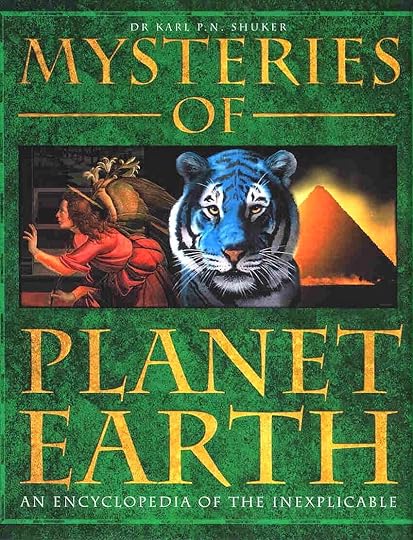
Published on June 14, 2014 18:38
June 13, 2014
THE PARTRIDGE CREEK MONSTER - A LIVING DINOSAUR IN THE YUKON?
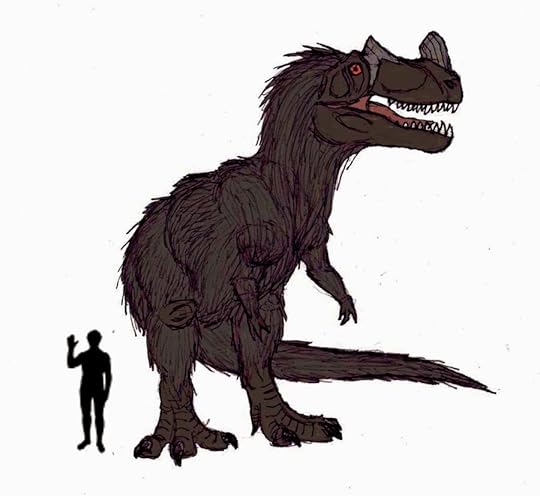 st1\:*{behavior:url(#ieooui) } Artistic representation of the Partridge Creek monster (© Connor Lachmanec, aka TheMorlock on deviantart.com)
st1\:*{behavior:url(#ieooui) } Artistic representation of the Partridge Creek monster (© Connor Lachmanec, aka TheMorlock on deviantart.com)The Arctic wastelands of the Yukon Territory, on the borders of Canada and Alaska, are surely the last place anyone might expect to meet a dinosaur - which is why the following case merits a prominent place among the dubitanda of cryptozoology.
The extraordinary tale of the beast from Partridge Creek debuted on 15 April 1908, within the pages of a French journal called Je Sais Tout ('I Know All'), and was recounted by one of the creature's eyewitnesses, French traveller Georges Dupuy. According to Dupuy, the adventure had begun one day in 1903, when a banker from San Francisco called James Lewis Buttler and a local gold prospector named Tom Leemore were hunting three large moose amid the marshy tundra countryside near the Yukon's Clear Creek, about 100 miles east of Dawson City. Suddenly, one of these burly deer raised its head as if it had heard something unexpected in the vicinity, and just as it did so a second member of the trio emitted a loud bellow of alarm, sending all three of them fleeing southwards with all speed.
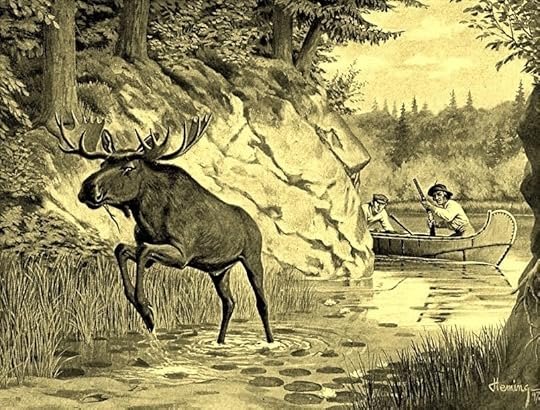 A hunted moose fleeing the scene, an engraving from 1897 by Arthur Heming
A hunted moose fleeing the scene, an engraving from 1897 by Arthur HemingStanding 7 ft at the shoulder and weighing up to half a ton, as the world's largest living species of deer the moose is not a creature to be readily intimidated by anything - which is why the two hunters were so surprised by their quarry's impromptu flight. When they reached the spot from where the moose had fled, however, the reason for these creatures' uncharacteristic behaviour became clear - there in the snow was the clear impression of an enormous body belonging to some unidentifiable beast of monstrous proportions.
The beast's belly had ploughed into the river bed's swampy mud a massive furrow 30 ft long, 12 ft wide, and 2 ft deep, which was flanked by gigantic footprints measuring 2.5 ft across and 5 ft in length, each also yielding impressions of sharp 1-ft-long claws. Completing the clues left behind by this unseen goliath was the imprint of a mighty 10-ft-long tail spanning 16 in across its middle.
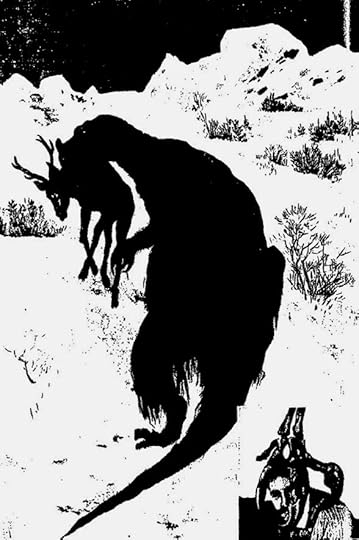 The first of two illustrations depicting the Partridge Creek monster in the Je Sais Tout article
The first of two illustrations depicting the Partridge Creek monster in the Je Sais Tout articleNotwithstanding the nightmarish visions conjured up by such dramatic dimensions, the two men decided to follow the monster's tracks, which led after several miles to a gulch known as Partridge Creek, where the tracks simply came to an end - giving the men cause to speculate that it must have leapt directly up into the gulch's encompassing cliffs.
Following this, they made their way by canoe along the McQuesten River to the nearby outpost of Armstrong Creek - an Indian village where Buttler had earlier arranged to meet Dupuy to take him hunting, and which was home to the Reverend Father Pierre Lavagneux, a French-Canadian Jesuit priest. When Dupuy and the priest heard about the monster, they were highly sceptical at first, but eventually Buttler persuaded them to return to Partridge Creek with Leemore and himself in a second search for it, aided by some local Indians.
After a day's intensive but fruitless search of the immediate area and some distance beyond it in all directions, however, the party of weary beast hunters had resigned themselves to failure, and decided to establish camp at the top of a rocky ravine. Thoughts of confronting monsters had been largely suppressed by the more practical goal of preparing a warm meal - until, wholly without warning, they received a terrifying reminder of the reason for their presence there. A hideous roar broke the Arctic stillness, and as the startled hunters reached for their rifles, one of them pointed with shaking hand to the opposite side of the ravine - where the crimson rays of the dying sun revealed a heart-stopping sight. A veritable monster in every sense of the word was clambering up its slope!
 The second of two illustrations depicting the Partridge Creek monster in the Je Sais Tout article
The second of two illustrations depicting the Partridge Creek monster in the Je Sais Tout articleBlack in colour, at least 50 ft long, and estimated by Buttler to weigh about 40 tons, their horrific visitor continued to climb upwards for a time, mercifully unaware of its terrified human eyewitnesses' close proximity. When it was about 200 paces away, it paused for 10 minutes or so, furnishing them with ample opportunity to observe it at close range in all its spine-chilling glory. Although profusely splattered with thick mud, its hide could be seen to bear many coarse, grey-black bristles like those of a wild boar, and a hideous mass of blood and saliva oozed from its cavernous jaws. Most remarkable of all, however, was the rhino-like horn perched prominently if somewhat incongruously near the end of its snout.
The Indians cowered in terror behind a large rock, and the others were rendered momentarily speechless by the monstrous apparition, but when it became clear that it had not detected them the priest gained sufficient control of his voice to whisper between still-chattering teeth: "A ceratosaurus...It's a ceratosaurus of the Arctic Circle!". Ceratosaurus nasicornis was a large flesh-eating bipedal dinosaur of the Jurassic Period, related to the later, larger Tyrannosaurus rex and readily identified via the large horn near the tip of its upper jaw.
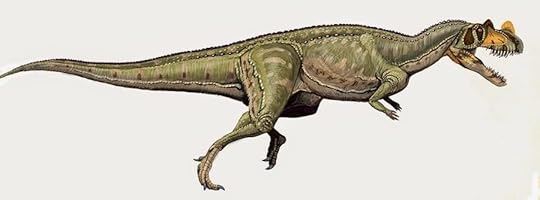 A modern-day reconstruction of Ceratosaurus nasicornis (© DiBgd/Wikipedia)
A modern-day reconstruction of Ceratosaurus nasicornis (© DiBgd/Wikipedia)As they continued to watch, the beast suddenly reared up onto its massive hind legs like a hellish kangaroo, gave voice to an ear-splitting roar again, and then disappeared back down into the ravine via a single immense bound. Not too surprisingly, the beast hunters found that the thrill of pursuing this creature had lost its former charm, and the following morning they journeyed back to Armstrong Creek. Dupuy later attempted to interest the Canadian governor at Dawson City in supplying them with a large-scale hunting party of mules and 50 armed men, but when this failed he returned home to France.
The matter was not quite over, however, for in January 1908 he received a letter from Father Lavagneux, dated Christmas Day 1907, in which the priest informed him that on Christmas Eve, and while in the company of ten Indians, he had seen their monstrous quarry once again - this time racing at speed over the creek's frozen river, with what seemed to be the carcase of a caribou clamped between its great jaws. Tracks identical to those found back in 1903 were clearly visible in the deep mud, and were followed by Lavagneux and company for at least two miles before being obliterated by falling snow.
That appears to have been the last time that the beast of Partridge Creek was spotted, either by Lavagneux or by anyone else, for there does not seem to be any further records on file alluding to this extraordinary creature. Bearing in mind, however, that the existence of such an entity calls for our belief not only in the post-Cretaceous persistence of an endothermic hairy dinosaur but also its existence in what must surely be the least compatible habitat for any type of large reptile living today, its lack of cryptozoological credibility should hardly come as a great surprise!
This ShukerNature post was excerpted from my book In Search of Prehistoric Survivors , which will be reissued later this year.
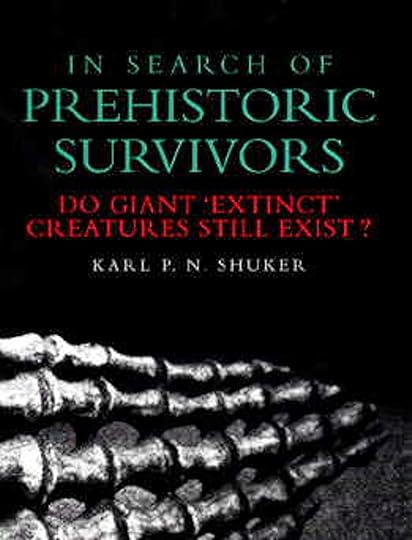 The original edition of In Search of Prehistoric Survivors
The original edition of In Search of Prehistoric Survivors
Published on June 13, 2014 03:37
June 8, 2014
KING HARES AND GIANT RABBITS - KEEPING CRYPTOZOOLOGY ON THE HOP!
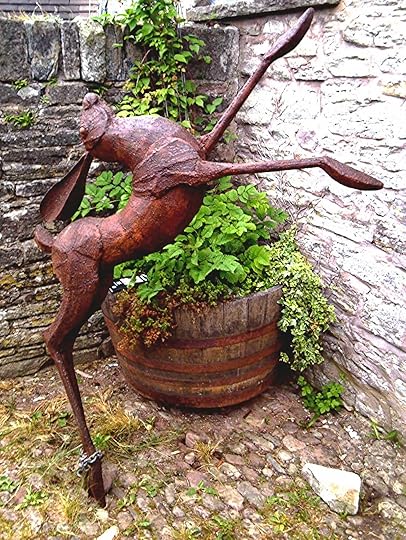 Statue of a giant hare at Hay on Wye (© Dr Karl Shuker)
Statue of a giant hare at Hay on Wye (© Dr Karl Shuker)Hares are among the most delightful and enigmatic of British mammals, and down through the ages they have been many things to many people – symbols of fertility, the moon, and Easter, to name but a few. They have also been described in many ways – magical, mystical, and even mad, but never monstrous, surely? However, a number of eyewitness accounts have been filed from various parts of the British Isles that describe mysterious, unidentified animals resembling hares, or even rabbits, but of truly monstrous, massive proportions. What could such extra-large lagomorphs be? Here is a selection of reported encounters with these so-called king hares and giant rabbits.
THE KING HARE OF DORSET
It was to the following mystery beast that the term 'king hare' was first applied. During a lengthy two-month-long hike from the Cotswolds, through the Wiltshire Downs and west Dorset's coastal regions, before ending in Butleigh near Glastonbury in Somerset, by early September 1976 Louise Hodgson had reached the Dorset hamlet of Uploders. She and two gypsy men whom she'd met a little earlier were walking their dogs together along a lonely track there one evening, in search of some hares or rabbits to catch and eat, when they came to a valley, in which they spied a group of about ten hares together – an unusual sight in itself, as these animals are normally solitary at that time of year.
 Brown hares depicted in an engraving from 1892
Brown hares depicted in an engraving from 1892But even more unusual was the presence of what they initially took to be a roe deer among the hares – until they peered closer and realised to their amazement that it too was a hare, but one of enormous dimensions. They stayed for a while, gazing in wonder at this prodigious creature and keeping hold of their dogs to ensure that they did not chase after it, before finally walking away, leaving behind the king-sized hare and its normal brethren.
THE MEGA-BIG BUNNY OF BANBURY
Banbury in Oxfordshire was the epicentre of a couple of notable sightings in more recent times. The first of these took place one early evening during summer 2005. Driving home to Wendlebury, just 20 miles south of Banbury, Clive Parker observed squatting at the roadside what he considered to be a gigantic rabbit. He estimated it to be as big as a large dog, light brown in colour, with a somewhat pointed face, and sitting on its haunches watching him as he drove past. It took a few seconds for this bizarre sight to register in his shocked mind, but once it did he stopped and swiftly reversed to the spot where he'd seen this creature. Inevitably, however, the mega-bunny was gone.
 A Flemish giant fawn doe, weighing approximately 20 lb (public domain)
A Flemish giant fawn doe, weighing approximately 20 lb (public domain)Clive Parker was alone when he made his observation, but the second sighting, which occurred on 24 October 2006, featured multiple eyewitnesses. These were Tim Hill, his family, and some friends, who were all taking part in a canal boat journey, travelling north along the Napton-Banbury route. On the highest stretch of the canal, they looked to their right across a sloping field, and spied what they assumed at first to be a deer. Roughly the size of a golden retriever dog, it sported reddish-gold fur, but seemed to have rather big ears for a deer. When Tim's wife Mandy and one of their friends, David, both looked at it through binoculars, however, they were astonished to discover that it was what they later described as a giant rabbit. While everyone was watching it, this remarkable animal bounded away into a hedge close by, and was not seen by them again. They felt that it was too chubby and rounded to have been a hare, and was not like a wallaby or kangaroo either – it was simply like a normal domestic rabbit, but one of decidedly abnormal stature.
THE WOR-RABBIT OF FELTON
Just a few months before the Banbury encounter by Tim Hill and company, a similar mystery creature had been hitting the news headlines much further north, in and around the village of Felton in Northumberland. The first media reports emerged during early April 2006, when twelve disgruntled local gardeners who maintained allotments on public ground in Felton complained that their prized vegetables were being regularly trampled upon and munched during night-time raids carried out by a dog-sized rabbit, black and brown in colour, and which left behind giant-sized footprints bigger even than a deer's. The first sighting had been made in February by one of the gardeners, Jeff Smith, and three other villagers also caught sight of it later.
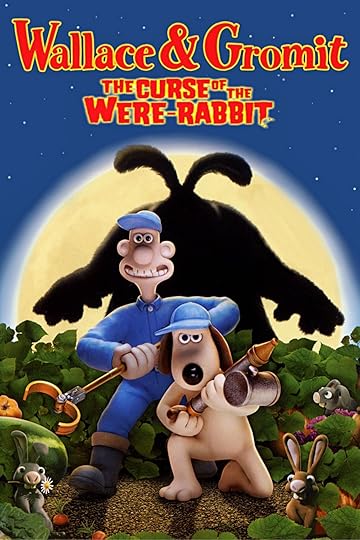 Poster for Wallace & Gromit – The Curse of the Were-Rabbit (© USA Theatrical and Worldwide DVD-Video/DreamWorks Animation)
Poster for Wallace & Gromit – The Curse of the Were-Rabbit (© USA Theatrical and Worldwide DVD-Video/DreamWorks Animation)With such reports receiving publicity not only so soon after April Fool's Day but also not long after the cinema release of the Wallace and Gromit film The Curse of the Were-Rabbit, a degree of scepticism was undoubtedly justified, but the allotment gardeners' protestations continued unabatedly, and the evidence of their squashed (and scoffed) produce was there for all to see. In addition, they announced that they were hiring two gunmen to mount guard upon their allotments, and who would shoot the giant rabbit on sight. Thanks to global online interest in this elusive animal, however, which by now had been variously – and amusingly - dubbed Bigs Bunny and the Wor-Rabbit in media accounts, the gardeners' statement swiftly attracted condemnation from readers worldwide. Some even offered to pay for the rabbit's unharmed capture and transportation to them.
Such requests proved unnecessary, however, when on 11 May, Rael Rawlinson, a local 18-year-old student, revealed that a month earlier, while she was driving along a road near to Felton with friends late one night, what she referred to as a "massive, abnormally big" rabbit had abruptly bounded across the road directly in front of them and had been fatally run over by her car. Such was the impact of the collision that her car's bumper had been cracked and was virtually hanging off, and when examined a tuft of rabbit fur was found attached to it. Getting out of her car, Rael had scrutinised the creature's body, which she claimed was at least 2 ft long and was very tall too, but she did not think to salvage it. When she told others what had happened, they visited the spot to find the body, but it had gone, no doubt taken by a fox or stray dog. And as no further nocturnal escapades in the allotments have been reported, it does indeed seem that the Felton mega-rabbit is no more.
KING HARES AND GIANT RABBITS IN IRELAND
Giant lagomorphs are apparently not confined to the island of Great Britain – comparable creatures have also been reported from Ireland.
During the late 1970s, while fishing one day with his father in a rowing boat at Lough Ree on the River Shannon, Morgan C. Jones of Dublin caught sight of what, when viewed through binoculars, seemed to resemble a huge rabbit, on an island in the middle of the lough.
 Irish hares (Archibald Thorburn, public domain)
Irish hares (Archibald Thorburn, public domain)Almost a decade later, during the mid-1980s, aged in his 30s, Andrew Munro of County Cork was in his mother's garden when, while walking through a gateway, he almost collided with an enormous hare. Standing on its hind legs with ears erect, it was over 4 ft tall as far as Andrew could estimate, and he and the hare stood looking at each other for what seemed like ages, even if in reality it was no more than a couple of minutes. This spell was abruptly broken, however, when Andrew's dog spotted the hare and immediately charged towards it. But with just a few huge leaps, the king hare readily evaded its canine aggressor, showing no fear – indeed, it actually seemed contemptuous of the dog – as it bounded swiftly out of the garden, across the drive, through the fence, and across a nearby field, leaving Andrew's frustrated dog far behind.
IN SEARCH OF IDENTITIES
So what could these most curious of creatures be? As far as the giant rabbits are concerned, the most likely, reasonable explanation is that they are merely escaped or even deliberately released specimens belonging to one or more of the several breeds of giant domestic rabbit that have been developed in modern times, originally for their meat but which have become increasingly popular nowadays as pets too.
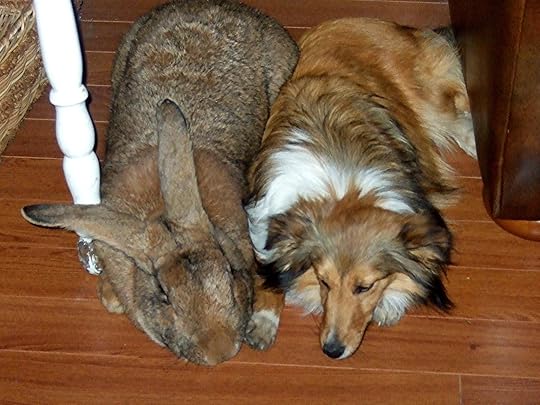 A Flemish Giant alongside an adult Shetland Sheepdog (© Stamastisclan/Wikipedia)
A Flemish Giant alongside an adult Shetland Sheepdog (© Stamastisclan/Wikipedia)Notable among these breeds is the Flemish Giant, originally bred as early as the 16th Century near Ghent in Belgium. Nowadays a frequently-exhibited show breed around the world and occurring in a wide range of colours, it can weigh as much as 30 lb without being obese, and in overall size is comparable to a cocker spaniel. Another extremely large breed is the Continental Giant, descended from the Flemish Giant. The world's largest rabbit currently alive is a Continental Giant named Ralph, who tips the scale at a truly staggering, non-obese weight of 55 lb!
Click here to view a YouTube video of Ralph, the world's largest rabbit.
There is little doubt that an absconded Flemish Giant or Continental Giant could plausibly explain the Banbury mega-rabbit, and rabbit experts consulted by the irate allotment owners in Felton also consider this a likely explanation for the demised wor-rabbit. Sadly, however, it is unlikely that they would survive long in the wild. Their huge size would readily attract unwelcome, potentially lethal attention from birds of prey, foxes, and stray dogs; and they would have no knowledge of how to avoid motor vehicles, as the Felton wor-rabbit fatally demonstrated.
But what of the king hares? The British Isles is home to two indigenous species of hare. The most common, widespread, and familiar of these is the brown hare Lepus europaeus, which is absent from Ireland as a native species (though it has been introduced into Northern Ireland) but is distributed throughout Great Britain and various offshore islands. One of the world's largest species of hare, it can attain a body length of up to 30 in, plus a tail length of up to 6 in, which means that individuals at the upper end of this species' size range can be as much as 3 ft, and can weigh up to 11 lb, i.e. as big as a decent-sized dog.
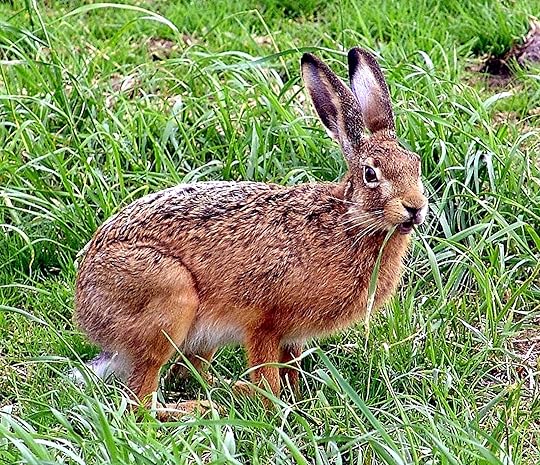 The brown hare (public domain)
The brown hare (public domain)As many people do not realise that hares in Britain can attain such notable dimensions, the sight of an exceptionally large hare coupled perhaps in some cases with less than accurate size-estimation skills on the part of its observer(s) may be sufficient to 'create' a king hare. Moreover, there might be individual hares possessing a mutant gene that expresses extra-large body size, or even suffering from a hormonal imbalance that results in gigantism, comparable to various endocrinologically-based conditions recorded from humans.
The second species of British hare is the mountain hare Lepus timidus, which, as its name suggests, is particularly adapted for a montane existence, and famously turns white in winter. It has been introduced into Scotland's Lowlands, many of its islands, and to the English Pennines, but is indigenous to the Scottish Highlands, and also to Ireland - represented here by a very distinctive subspecies, the Irish hare L. t. hibernicus, found nowhere else.
 White winter phase of the mountain hare (public domain)
White winter phase of the mountain hare (public domain)This is another large hare, only slightly smaller than the brown hare, and all that has been suggested above as explanations for king hare sightings in Great Britain applies equally to such sightings in Ireland too – plus one intriguing additional possibility.
BELGIAN HARES AND PATAGONIAN CAVIES
After Morgan C. Jones had observed a giant rabbit on the island in the River Shannon where he and his father were fishing, his father told him that during the 1940s, a very large domestic breed of lagomorph known as the Belgian hare, much bigger in size than the Irish hare, was introduced into the Irish Republic as a potential food source. Unfortunately, it bred so prolifically, posing a major risk to the ecosystem, that it was subsequently eradicated, with the last specimens having been corralled on the very island where Morgan had seen his giant rabbit – thus suggesting that what he had spied was an elusive, still-surviving Belgian hare. Making this even more interesting is the fact that despite its name, the Belgian hare is not a hare at all, but a breed of rabbit, albeit one bred specifically to look superficially hare-like, hence its name.
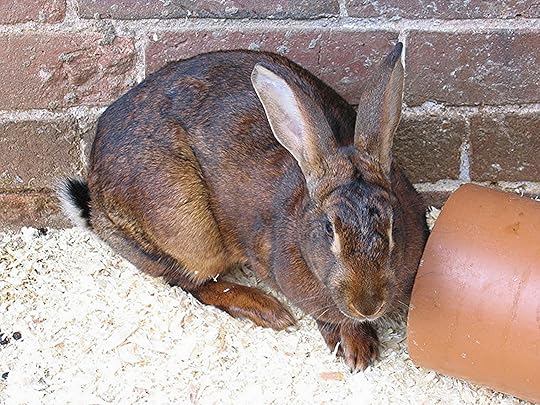 Belgian hare (© Quimby/Wikipedia)
Belgian hare (© Quimby/Wikipedia)There is also the prospect that some supposed king hares and giant rabbits, especially if only glimpsed briefly, were not bona fide lagomorphs at all, but were instead escapee or naturalised wallabies (there are naturalised populations living in several regions of Great Britain), or even those introduced but successfully-thriving small Asian deer known as muntjacs. One further non-native species well worth considering in relation to this prospect is a very curious South American rodent known as the mara or Patagonian cavy Dolichotis patagonum. It is very commonly exhibited in zoos and wildlife parks, but despite being related to guinea pigs it is extremely hare-like in overall appearance, due to its long limbs and ears plus its general body form and stance.
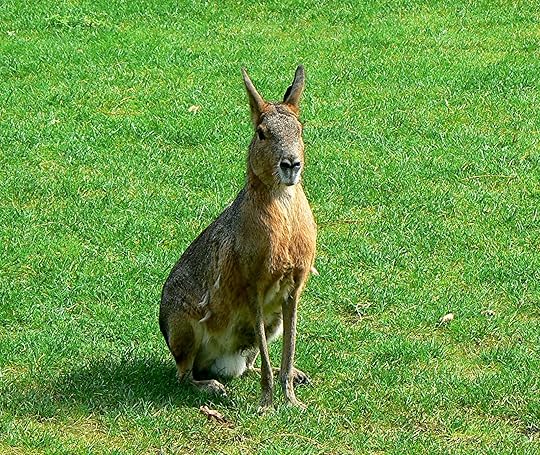 As seen here, the mara or Patagonian cavy can look very hare-like (public domain)
As seen here, the mara or Patagonian cavy can look very hare-like (public domain)Moreover, as one of the world's largest rodents, it could easily be mistaken for a giant hare by observers not familiar with its species, so an escapee mara existing in a given area could certainly explain reported sightings there of supposed king hares or long-legged giant rabbits.
AND FINALLY…
Remembering the hare's many traditional links to pagan lore, the occult, and even Faerie, it is only fitting that the final account of a giant mystery hare documented here is one that seemingly transcends normal cryptozoological boundaries and ventures into the preternatural.
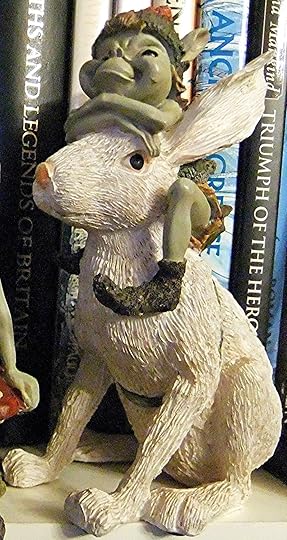 My figurine of a pixie riding a white hare (© Dr Karl Shuker)
My figurine of a pixie riding a white hare (© Dr Karl Shuker)While walking alone one bright summer morning through Windsor Great Park, Sibell Lilian Blunt-Mackenzie, 3rd Countess of Cromartie (1878-1962), saw a bizarre-looking animal slowly approaching her. It resembled a hare, and moved with a typically leporine, loping gait too, but it was huge, as big as a goat! Making it even more caprine in appearance, however, was the pair of curved horns that it bore upon its head. The countess was so astonished by this uncanny beast that she stood motionless, until, as it passed by her, she struck out at it with her parasol – and it immediately vanished! A strange tale indeed, but when dealing with creatures as magical and evanescent as hares, nothing should really surprise us. Or, to put it another way: hare today, gone tomorrow!
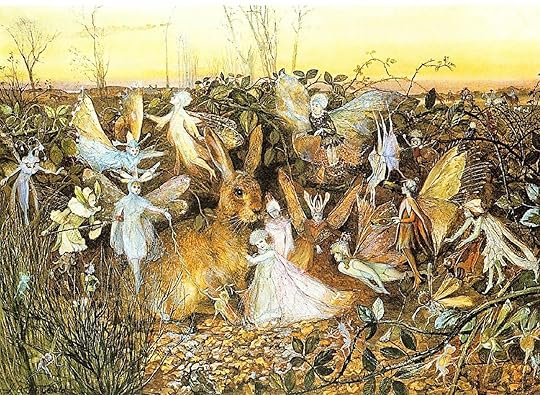 The beautiful (if inaccurately-entitled?) painting A Rabbit Among the Fairies (the 'rabbit' is surely a brown hare!), by the popular Victorian fantasy artist John Anster Fitzgerald
The beautiful (if inaccurately-entitled?) painting A Rabbit Among the Fairies (the 'rabbit' is surely a brown hare!), by the popular Victorian fantasy artist John Anster FitzgeraldSource acknowledgement: Some of the above reports originally appeared in the readers' letters pages of the British monthly periodical Fortean Times.
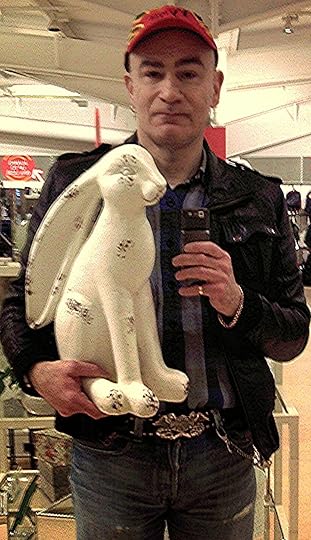 Holding a magical white hare at Easter (© Dr Karl Shuker)
Holding a magical white hare at Easter (© Dr Karl Shuker)
Published on June 08, 2014 16:44
Karl Shuker's Blog
- Karl Shuker's profile
- 45 followers
Karl Shuker isn't a Goodreads Author
(yet),
but they
do have a blog,
so here are some recent posts imported from
their feed.



